ASUSTeK Computer R1F Notebook PC User Manual rev 1
ASUSTeK Computer Inc Notebook PC rev 1
Contents
user manual rev 1
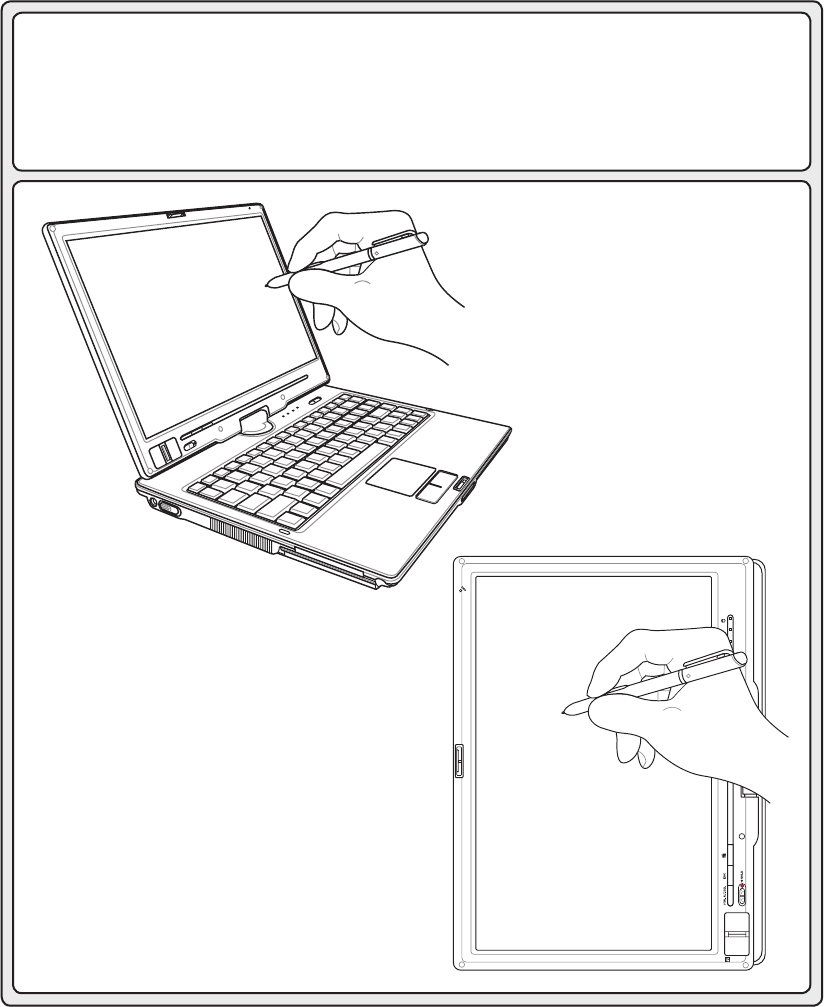
Notebook PC
Hardware User’s Manual
E2541 / Apr 2006

2
Contents
1. Introducing the Notebook PC ...................................................................5
About This User’s Manual ..........................................................................................6
Notes For This Manual ........................................................................................... 6
Preparing your Notebook PC...................................................................................... 9
2. Knowing the Parts ................................................................................... 11
Top Side....................................................................................................................12
Bottom Side .............................................................................................................. 14
Left Side ...................................................................................................................16
Right Side ................................................................................................................. 17
Rear Side..................................................................................................................18
Front Side ................................................................................................................. 20
3. Getting Started .........................................................................................21
Power System ..........................................................................................................22
Using AC Power ...................................................................................................22
Second Battery Pack ........................................................................................... 22
Using Battery Power ............................................................................................23
Battery Care ......................................................................................................... 23
Powering ON the Notebook PC ...........................................................................24
The Power-On Self Test (POST) .......................................................................... 24
Checking Battery Power ...................................................................................... 25
Charging the Battery Pack ................................................................................... 25
Restarting or Rebooting ....................................................................................... 26
Powering OFF ...................................................................................................... 26
Special Keyboard Functions ..................................................................................... 27
Colored Hot Keys ................................................................................................. 27
Microsoft Windows Keys ...................................................................................... 29
Keyboard as a Numeric Keypad .........................................................................29
Keyboard as Cursors ...........................................................................................29
Switches and Status Indicators ................................................................................ 30
Switches...............................................................................................................30
Status Indicators ..................................................................................................31

3
Contents
4. Using the Notebook PC ...........................................................................33
Operating System ..................................................................................................... 34
Support Software .................................................................................................34
Pointing Device.........................................................................................................35
Using the Touchpad .............................................................................................35
Touchpad Usage Illustrations ............................................................................... 36
Caring for the Touchpad ....................................................................................... 37
Storage Devices .......................................................................................................38
ExpressCard ........................................................................................................38
Optical Drive ........................................................................................................ 39
Module Bay .......................................................................................................... 40
Flash Memory Card Reader ................................................................................41
Hard Disk Drive .................................................................................................... 41
Connections..............................................................................................................42
Modem Connection .............................................................................................. 42
Network Connection ............................................................................................43
Wireless LAN Connection (on selected models) .................................................44
Bluetooth Wireless Connection (on selected models) ......................................... 45
Trusted Platform Module (TPM) (on selected models) ........................................46
Power Management Modes...................................................................................... 47
Full Power Mode & Maximum Performance ........................................................ 47
ACPI.....................................................................................................................47
Suspend Mode ..................................................................................................... 47
Power Savings ..................................................................................................... 47
Power State Summary ......................................................................................... 48
Thermal Power Control ........................................................................................ 48
Stand by and Hibernate .......................................................................................49
Tablet PC Mode ........................................................................................................ 50
Fingerprint Scanner .................................................................................................. 52
Appendix ......................................................................................................53
Optional Accessories ................................................................................................ 54
Glossary ................................................................................................................... 58
Declarations and Safety Statements ........................................................................ 62
Notebook PC Information ......................................................................................... 72
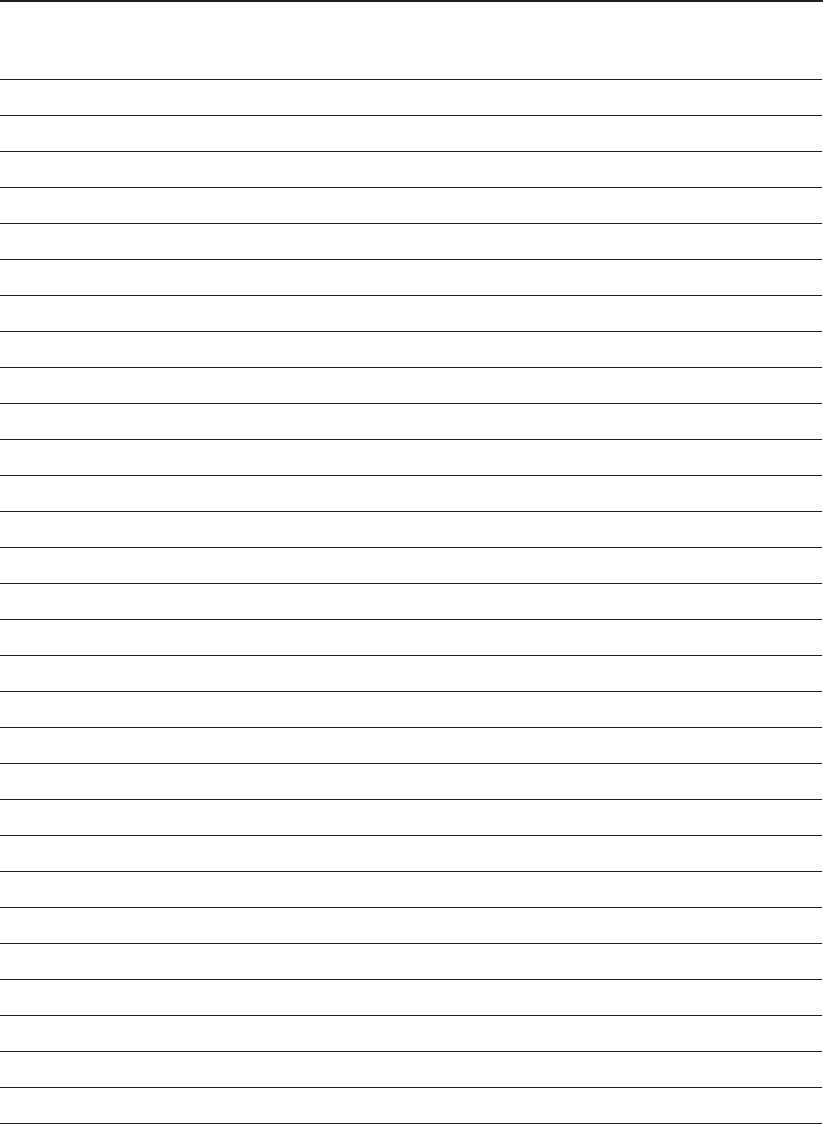
4
Contents
5
1. Introducing the Notebook PC
About This User’s Manual
Notes For This Manual
Safety Precautions
Preparing your Notebook PC
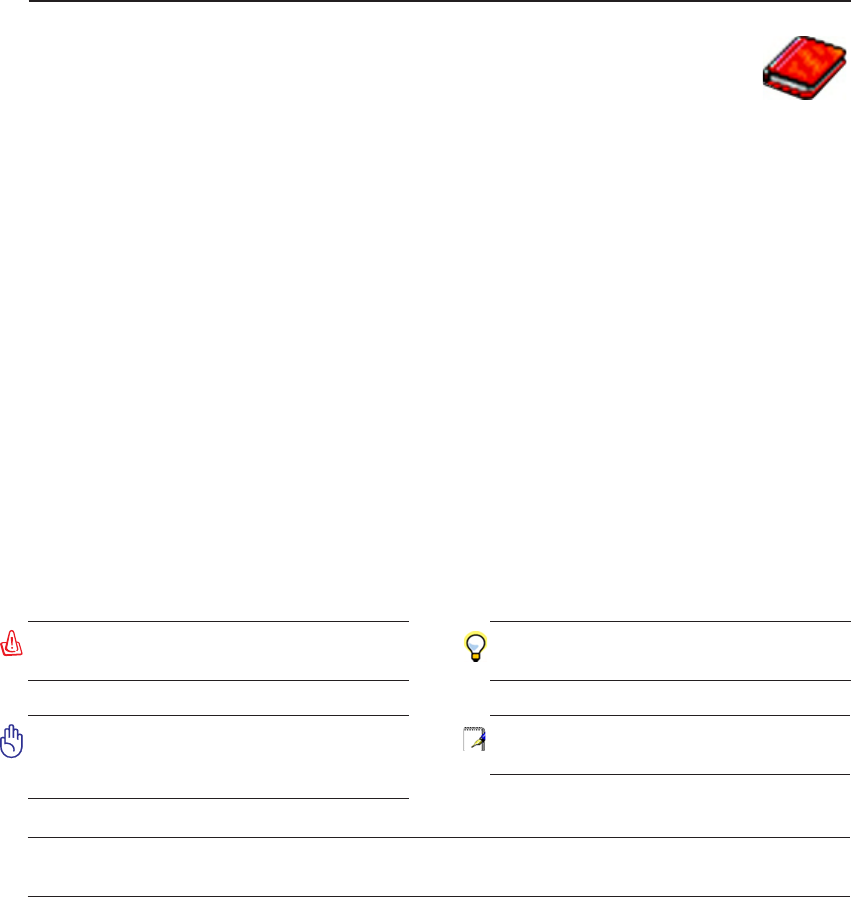
6
1 Introducing the Notebook PC
About This User’s Manual
You are reading the Notebook PC User’s Manual. This User’s Manual provides information
on the various components in the Notebook PC and how to use them. The following are
major sections of this User’s Manuals:
1. Introducing the Notebook PC
Introduces you to the Notebook PC and this User’s Manual.
2. Knowing the Parts
Gives you information on the Notebook PC’s components.
3. Getting Started
Gives you information on getting started with the Notebook PC.
4. Using the Notebook PC
Gives you information on using the Notebook PC’s components.
5. Appendix
Introduces you to optional accessories and gives additional information.
Notes For This Manual
A few notes and warnings in bold are used throughout this guide that you should be aware of in order
to complete certain tasks safely and completely. These notes have different degrees of importance as
described below:
NOTE: Tips and information for
special situations.
TIP: Tips and useful information for
completing tasks.
Text enclosed in < > or [ ] represents a key on the keyboard; do not actually type the
< > or [ ] and the enclosed letters.
< >
[ ]
WARNING! Important information that
must be followed for safe operation.
IMPORTANT! Vital information that
must be followed to prevent damage
to data, components, or persons.
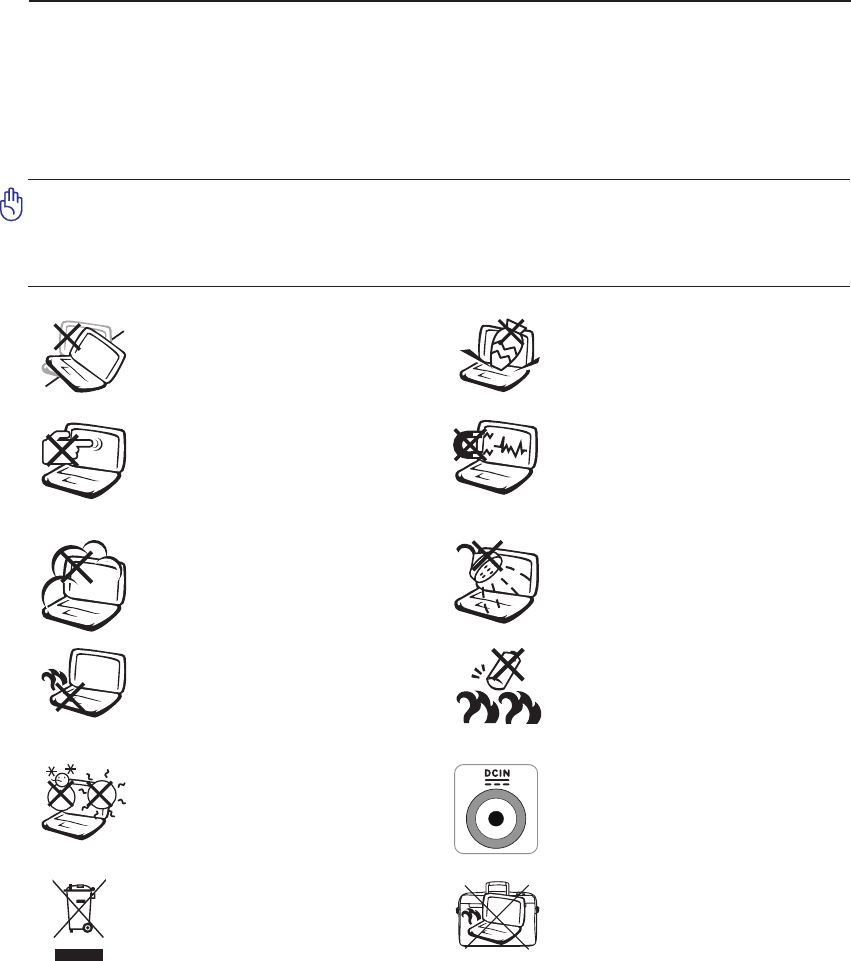
7
Introducing the Notebook PC 1
Safety Precautions
The following safety precautions will increase the life of the Notebook PC. Follow all precautions and
instructions. Except as described in this manual, refer all servicing to qualied personnel. Do not use
damaged power cords, accessories, or other peripherals. Do not use strong solvents such as thinners,
benzene, or other chemicals on or near the surface.
IMPORTANT! Disconnect the AC power and remove the battery pack(s) before clean-
ing. Wipe the Notebook PC using a clean cellulose sponge or chamois cloth dampened
with a solution of nonabrasive detergent and a few drops of warm water and remove
any extra moisture with a dry cloth.
DO NOT expose to or use near liquids,
rain, or moisture. DO NOT use the
modem during an electrical storm.
DO NOT expose to dirty or dusty en-
vironments. DO NOT operate during
a gas leak.
SAFE TEMP: This Notebook PC
should only be used in environments
with ambient temperatures between
5°C (41°F) and 35°C (95°F)
Battery safety warning:
DO NOT throw the battery in re.
DO NOT short circuit the contacts.
DO NOT disassemble the battery.
DO NOT expose to strong magnetic
or electrical elds.
DO NOT place on uneven or unstable
work surfaces. Seek servicing if the
casing has been damaged.
DO NOT place or drop objects on top
and do not shove any foreign objects
into the Notebook PC.
DO NOT press or touch the display
panel. Do not place together with
small items that may scratch or enter
the Notebook PC.
DO NOT leave the Notebook PC on
your lap or any part of the body in
order to prevent discomfort or injury
from heat exposure.
DO NOT throw the Notebook PC
in municipal waste. Check local
regulations for disposal of electronic
products.
DO NOT carry or cover a Notebook
PC that is powered ON with any ma-
terials that will reduce air circulation
such as a carrying bag.
INPUT RATING: Refer to the rating
label on the bottom of the Notebook
PC and be sure that your power adapter
complies with the rating.
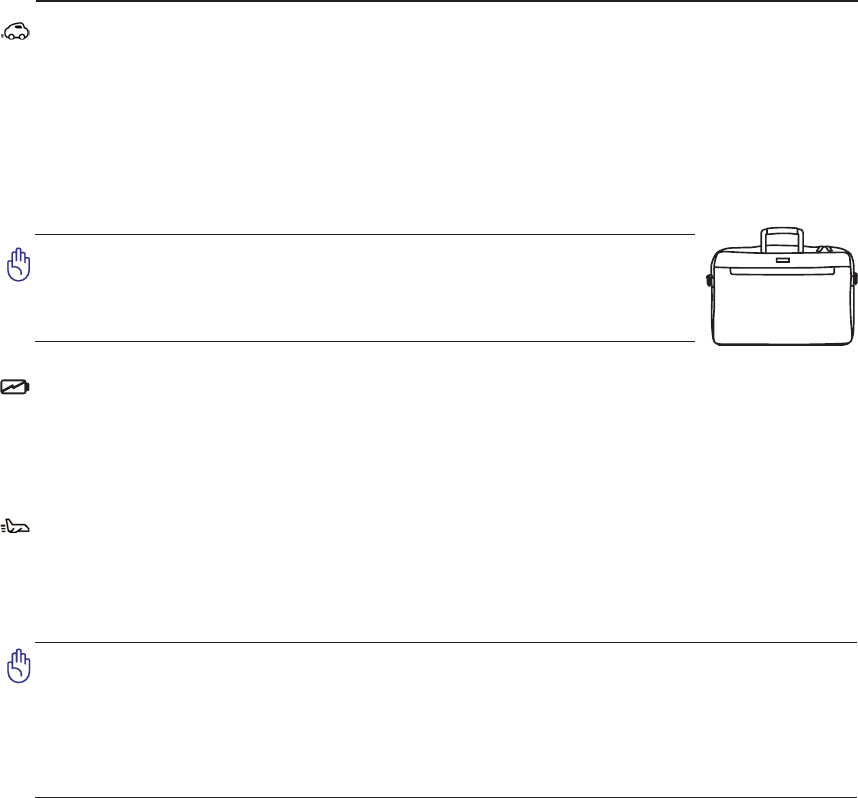
8
1 Introducing the Notebook PC
Transportation Precautions
To prepare the Notebook PC for transport, you should turn it OFF and disconnect all external peripher-
als to prevent damage to the connectors. The hard disk drive’s head retracts when the power is turned
OFF to prevent scratching of the hard disk surface during transport. Therefore, you should not transport
the Notebook PC while the power is still ON. Close the display panel and check that it is latched securely
in the closed position to protect the keyboard and display panel.
Cover Your Notebook PC
Charge Your Batteries
If you intend to use battery power, be sure to fully charge your battery pack and any optional battery
packs before going on long trips. Remember that the power adapter charges the battery pack as long as
it is plugged into the computer and an AC power source. Be aware that it takes much longer to charge
the battery pack when the Notebook PC is in use.
Airplane Precautions
Contact your airline if you want to use the Notebook PC on the airplane. Most airlines will have restric-
tions for using electronic devices. Most airlines will allow electronic use only between and not during
takeoffs and landings.
CAUTION! There are three main types of airport security devices: X-ray machines
(used on items placed on conveyor belts), magnetic detectors (used on people walking
through security checks), and magnetic wands (hand-held devices used on people or
individual items). You can send your Notebook PC and diskettes through airport X-ray
machines. However, it is recommended that you do not send your Notebook PC or
diskettes through airport magnetic detectors or expose them to magnetic wands.
CAUTION: The Notebook PC’s surface is easily dulled if not properly
cared for. Be careful not to rub or scrape the Notebook PC surfaces
when transporting your Notebook PC. You can purchase an optional
carrying case to protect it from dirt, water, shock, and scratches.
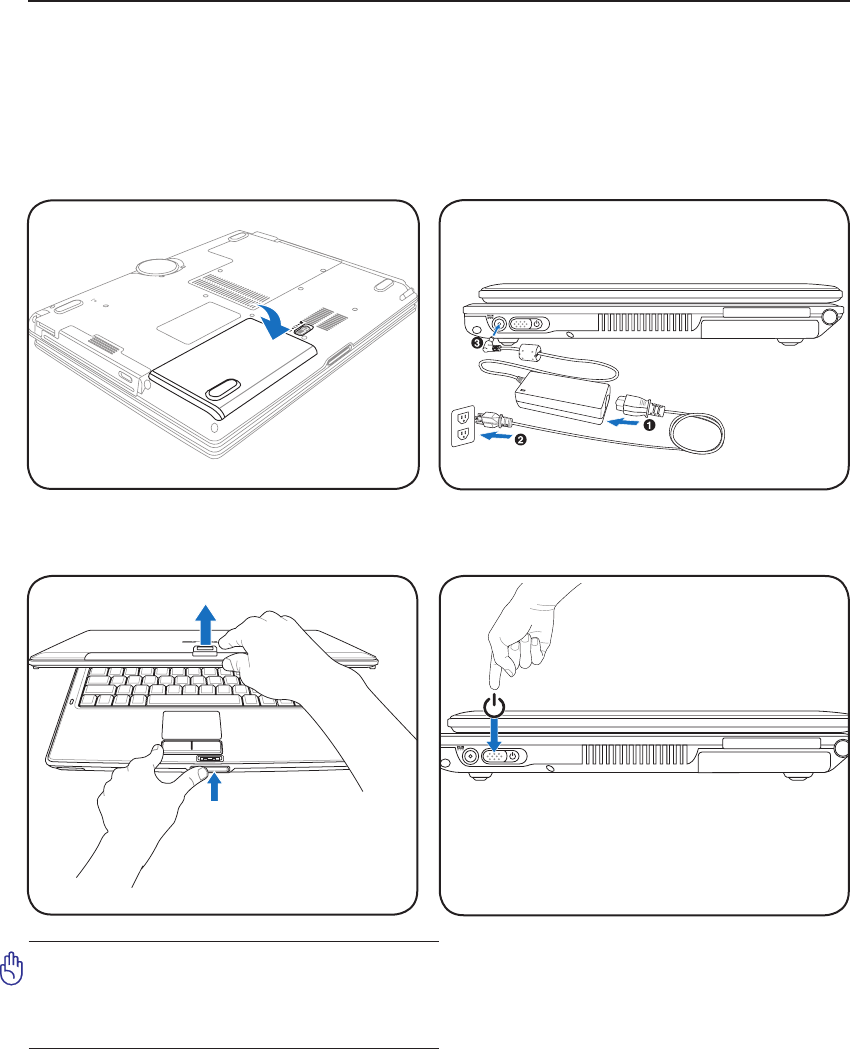
9
Introducing the Notebook PC 1
POWER
Preparing your Notebook PC
These are only quick instructions for using your Notebook PC. Read the later pages for detailed informa-
tion on using your Notebook PC.
1. Install the battery pack
3. Open the Display Panel 4. Turn ON the Notebook PC
2. Connect the AC Power Adapter
Slide the power button and release.
(In Windows XP, this button can also be used to
safely turn OFF the Notebook PC.)
IMPORTANT! When opening, do not force
the display panel down to the table or else
the hinges may break! Never lift the Note-
book PC by the display panel!
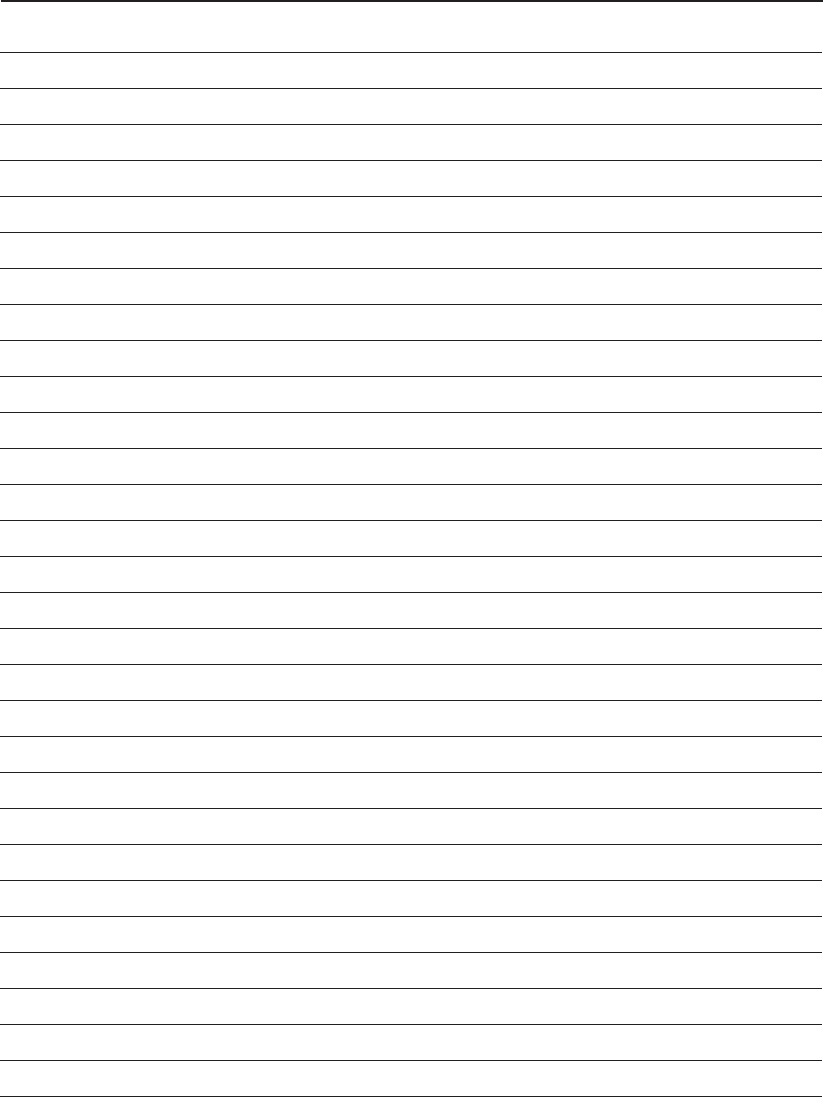
10
1 Introducing the Notebook PC
11
2. Knowing the Parts
Basic sides of the Notebook PC
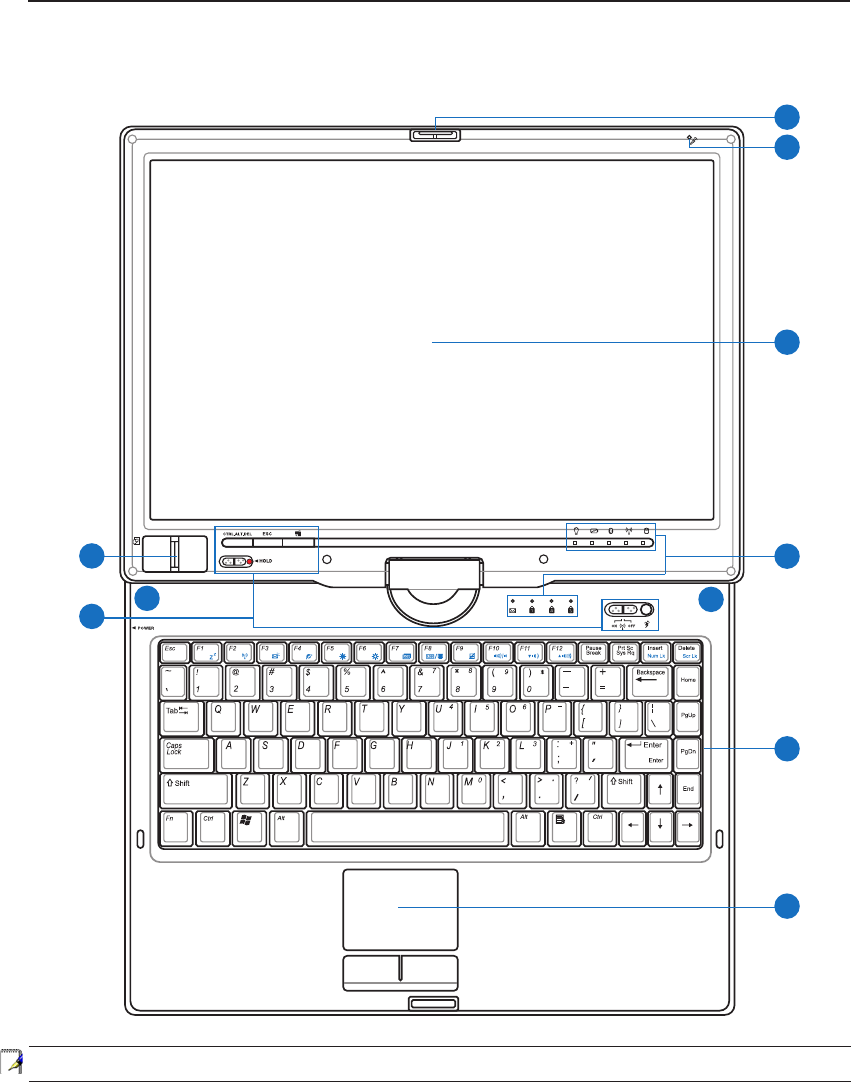
12
2 Knowing the Parts
Top Side
Refer to the diagram below to identify the components on this side of the Notebook PC.
NOTE: The keyboard will be different for each territory.
3
2
1
6
5
7
4
9
85
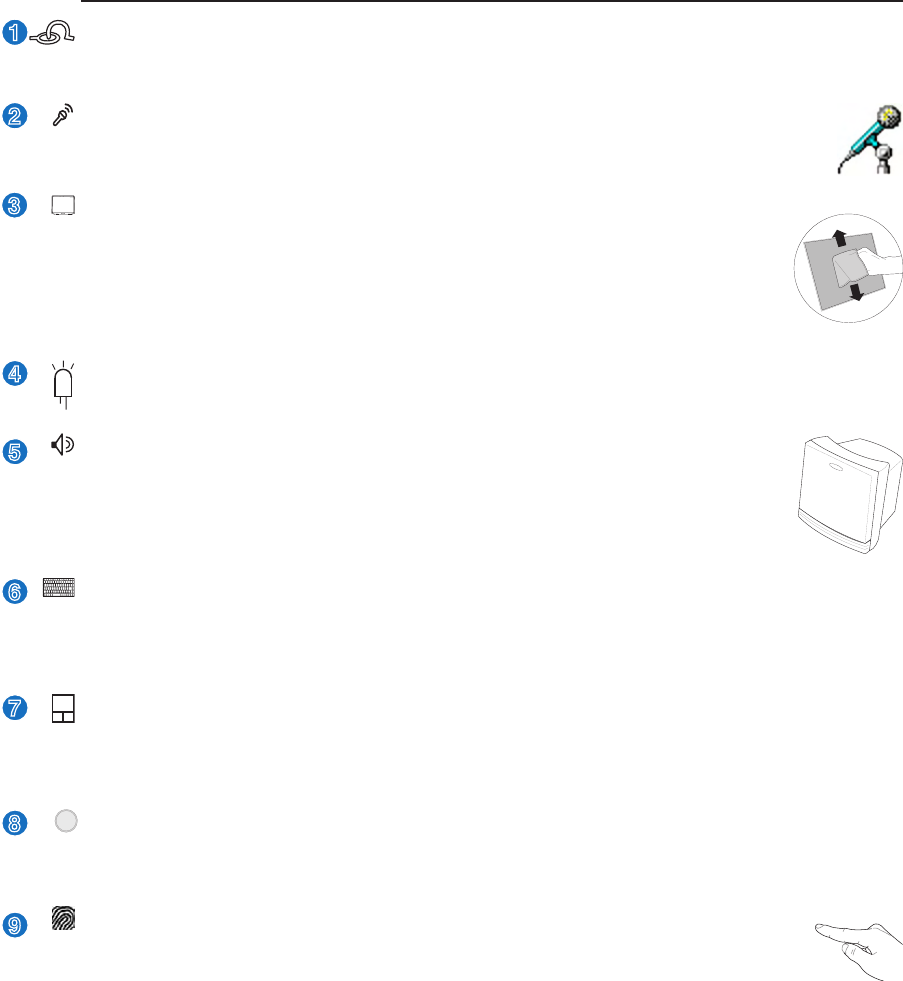
13
Knowing the Parts 2
2
3
4
5
6
1
Keyboard
The keyboard provides full-sized keys with comfortable travel (depth at which the keys can be depressed)
and palm rest for both hands. Two Windows™ function keys are provided to help ease navigation in the
Windows™ operating system.
Touchpad and Buttons
The touchpad with its buttons is a pointing device that provides the same functions as a desktop mouse.
A software-controlled scrolling function is available after setting up the included touchpad utility to al-
low easy Windows or web navigation.
Display Panel
The display panel functions the same as a desktop monitor. The Notebook PC uses an
active matrix TFT LCD, which provides excellent viewing like that of desktop monitors.
Unlike desktop monitors, the LCD panel does not produce any radiation or ickering,
so it is easier on the eyes. Use a soft cloth without chemical liquids (use plain water if
necessary) to clean the display panel.
Status Indicators
Status indicator details are described in section 3.
Microphone (Built-in)
The built-in mono microphone can be used for video conferencing, voice narrations, or simple
audio recordings.
Instant Keys
Instant keys allow you to launch frequently used applications with one push of a button. Details are
described in section 3.
7
8
9
Audio Speakers
The built-in stereo speaker system allows you to hear audio without additional attach-
ments. The multimedia sound system features an integrated digital audio controller
that produces rich, vibrant sound (results improved with external stereo headphones or
speakers). Audio features are software controlled.
Display Panel Reversible Latch
One reversible latch on the front of the Notebook PC locks the display panel in the closed position or in
the tablet PC mode. The reversible latch must be manually switched from one mode to the other.
Fingerprint Scanner
The ngerprint scanner allows use of security software using your ngerprint as your iden-
tication key.
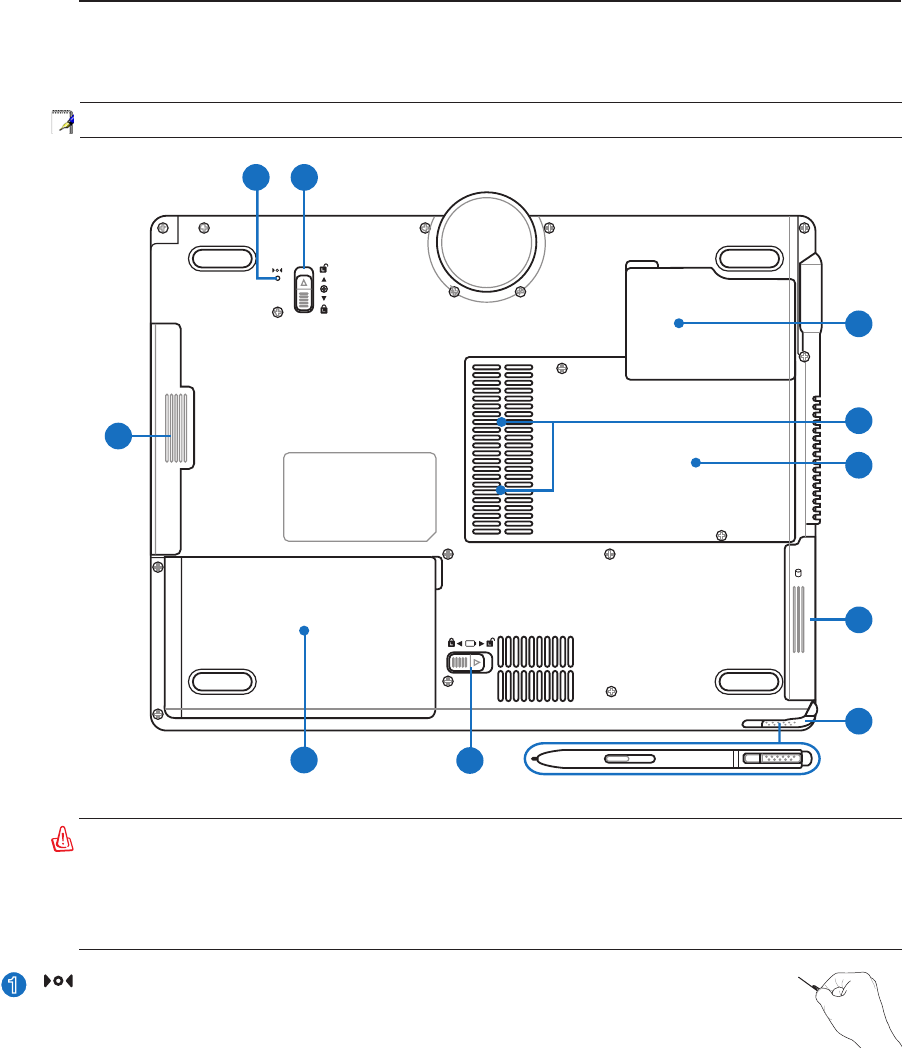
14
2 Knowing the Parts
1
Shutdown Button (Emergency)
In case your operating system cannot properly turn OFF or restart, the shutdown button
can be pressed with a straightened paper clip to shutdown the Notebook PC.
Bottom Side
Refer to the diagram below to identify the components on this side of the Notebook PC.
2
98
3
6
4
5
7
10
1
WARNING! The bottom of the Notebook PC can get very hot. Be careful when handling
the Notebook PC while it is in operation or recently been in operation. High tempera-
tures are normal during charging or operation. Do not use on soft surfaces such as
beds or sofas which may block the vents. DO NOT PUT THE NOTEBOOK PC ON YOUR
LAP OR OTHER PARTS OF THE BODY TO AVOID INJURY FROM THE HEAT.
NOTE: The bottom side may vary in appearance depending on model.
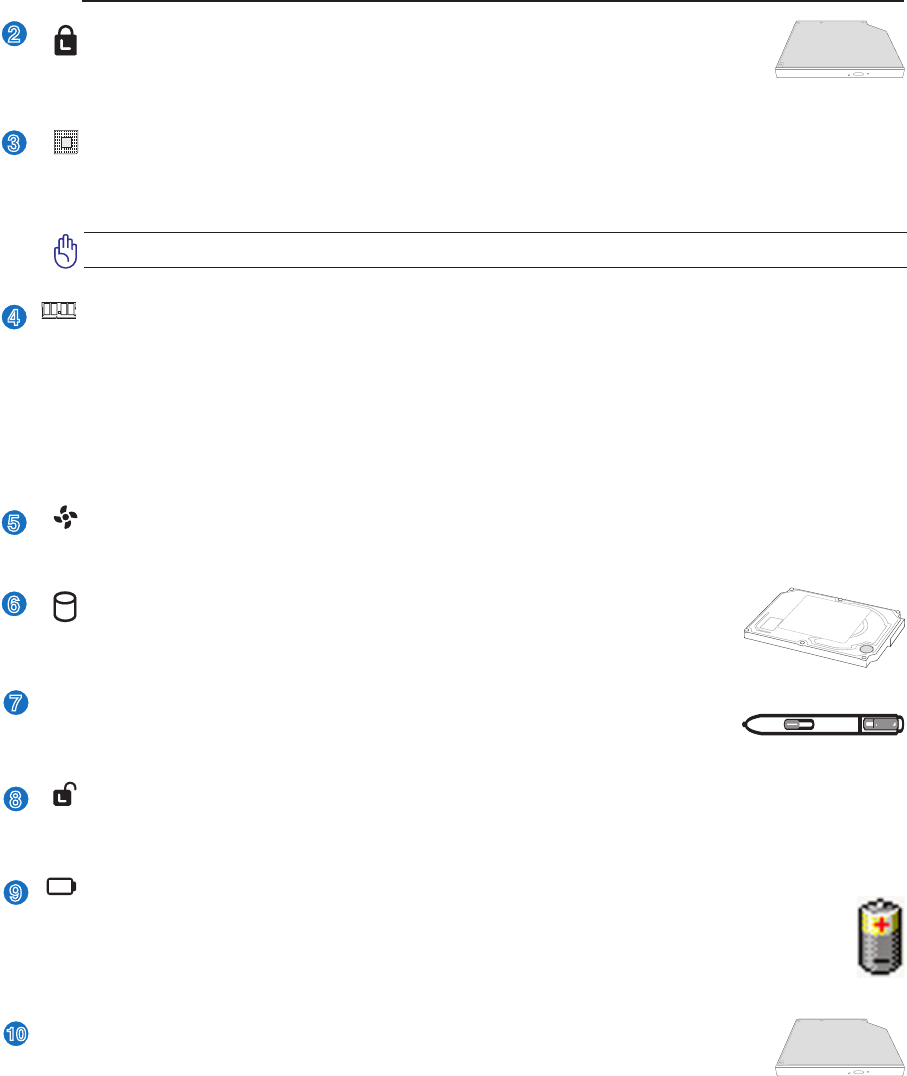
15
Knowing the Parts 2
2
3
4
Battery Lock - Spring
The spring battery lock is used to keep the battery pack secured. When the battery pack is inserted, it will
automatically lock. To remove the battery pack, this spring lock must be held in the unlocked position.
Memory (RAM) Compartment
The memory compartment provides expansion capabilities for additional memory. Additional memory
will increase application performance by decreasing hard disk access. The BIOS automatically detects
the amount of memory in the system and congures CMOS accordingly during the POST (Power-On-
Self-Test) process. There is no hardware or software (including BIOS) setup required after the memory
is installed. Visit an authorized service center or retailer for information on memory upgrades for your
Notebook PC. Only purchase expansion modules from authorized retailers of this Notebook PC to ensure
maximum compatibility and reliability.
Battery Pack
The battery pack is automatically charged when connected to an AC power source and maintains
power to the Notebook PC when AC power is not connected. This allows use when moving tempo-
rarily between locations. Battery time varies by usage and by the specications for this Notebook
PC. The battery pack cannot be disassembled and must be purchased as a single unit.
9
Hard Disk Drive Compartment
The hard disk drive is secured in a compartment. Hard disk drive upgrades are to
be done by authorized service centers or dealers only.
Central Processor Unit (CPU) Compartment
Some Notebook PC models feature a socketed-processor design to allow upgrading to faster processors
in the future. Some models feature a ULV design for compactness and may not be upgraded. Visit an
authorized service center or retailer for information on upgrades.
WARNING! End-user removal of the CPU or hard disk drive will void the warranty.
6
7
5
8
Module Lock
The Notebook PC has a user replaceable module. Visit an authorized dealer for com-
patible modules for this Notebook PC.
Optical Drive Module
This Notebook PC features a module bay to accept various modules such as optical
drives, travel drawer, or second battery pack. Visit an authorized dealer for upgrades.
CD/DVD
10
Touchscreen Pen Compartment
The touchscreen pen compartment allows storage of the pen used on the touch-
screen panel.
Cooling Fan
The cooling fan is activated to remove excess heat depending on temperature threshold settings.
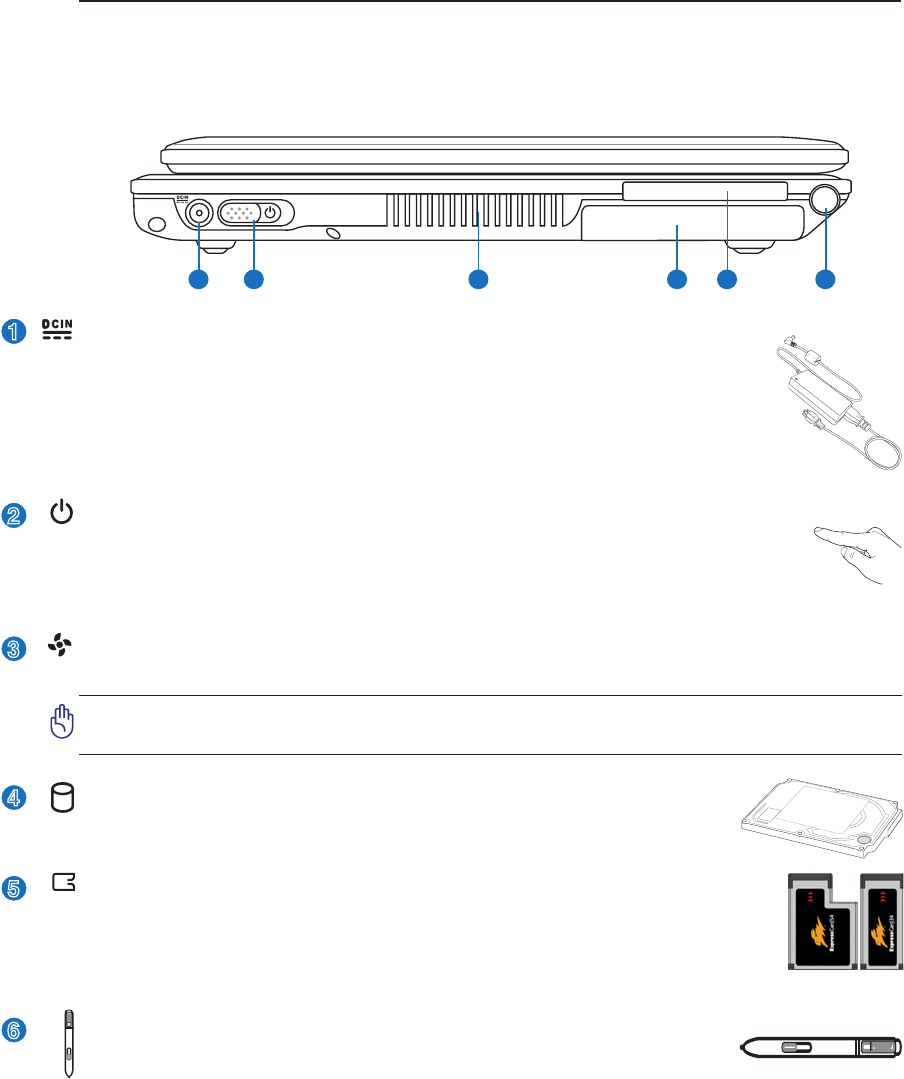
16
2 Knowing the Parts
Left Side
Refer to the diagram below to identify the components on this side of the Notebook PC.
1243 5 6
2
3
4
5
1
Power (DC) Input
The supplied power adapter converts AC power to DC power for use with this jack.
Power supplied through this jack supplies power to the Notebook PC and charges the
internal battery pack. To prevent damage to the Notebook PC and battery pack, always
use the supplied power adapter. CAUTION: MAY BECOME WARM TO HOT
WHEN IN USE. BE SURE NOT TO COVER THE ADAPTER AND KEEP IT
AWAY FROM YOUR BODY.
Power Switch
The power switch allows powering ON and OFF the Notebook PC and recovering from
STD. Use the switch once to turn ON and once to turn OFF the Notebook PC. In Windows
XP, this button can also be used to safely turn OFF the Notebook PC. The power switch only
works when the display panel is opened.
Air Vents
The air vents allow cool air to enter and warm air to exit the Notebook PC.
IMPORTANT! Make sure that paper, books, clothing, cables, or other objects do not
block any of the air vents or else overheating of the Notebook PC may occur.
ExpressCard Slot
One 26pin Express card slot is available to support one ExpressCard/34mm or one
ExpressCard/54mm expansion card. This new interface is faster by using a serial bus
supporting USB 2.0 and PCI Express instead of the slower parallel bus used in the PC
card slot. (Not compatible with previous PCMCIA cards.)
Hard Disk Drive Compartment
The hard disk drive is secured in a compartment. Hard disk drive upgrades are to
be done by authorized service centers or dealers only.
6
Touchscreen Pen Compartment
The touchscreen pen compartment allows storage of the pen used on the touch-
screen panel.
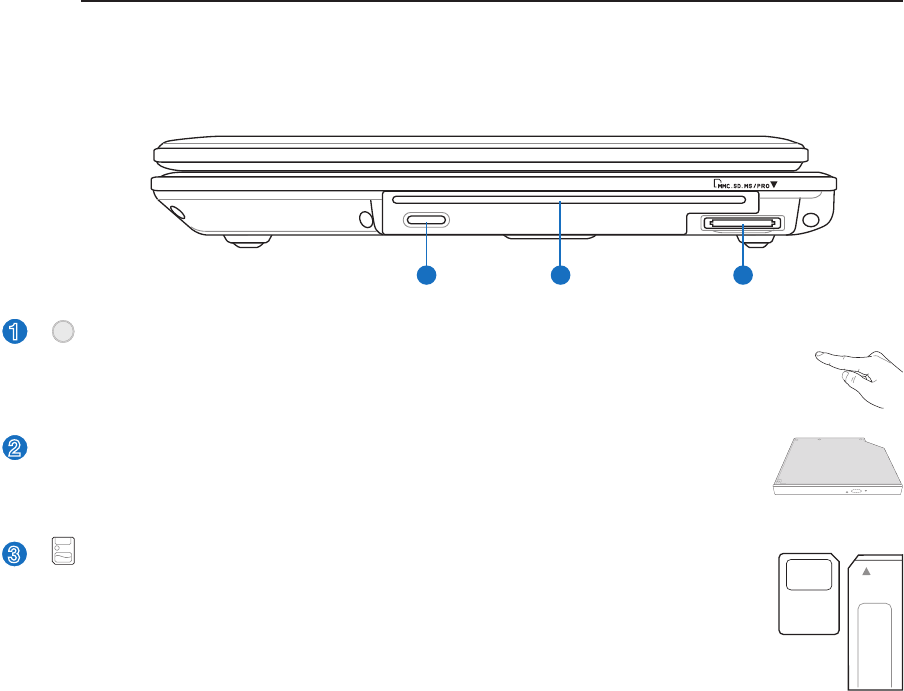
17
Knowing the Parts 2
Flash Memory Slot
Normally a PCMCIA or USB memory card reader must be purchased separately in
order to use memory cards from devices such as digital cameras, MP3 players, mobile
phones, and PDAs. This Notebook PC has a built-in memory card reader that can read
many ash memory cards as specied later in this manual. The built-in memory card
reader is not only convenient, but also faster than most other forms of memory card
readers because it utilizes the high-bandwidth PCI bus.
Optical Drive Electronic Eject
The optical drive eject has an electronic eject button for opening the tray. You can also eject
the optical drive tray through any software player or by right clicking the optical drive in
Windows™ “My Computer.”
Right Side
Refer to the diagram below to identify the components on this side of the Notebook PC.
123
2
3
1
Optical Drive Module
This Notebook PC features a module bay to accept various modules such as optical
drives, travel drawer, or second battery pack. Visit an authorized dealer for upgrades.
CD/DVD
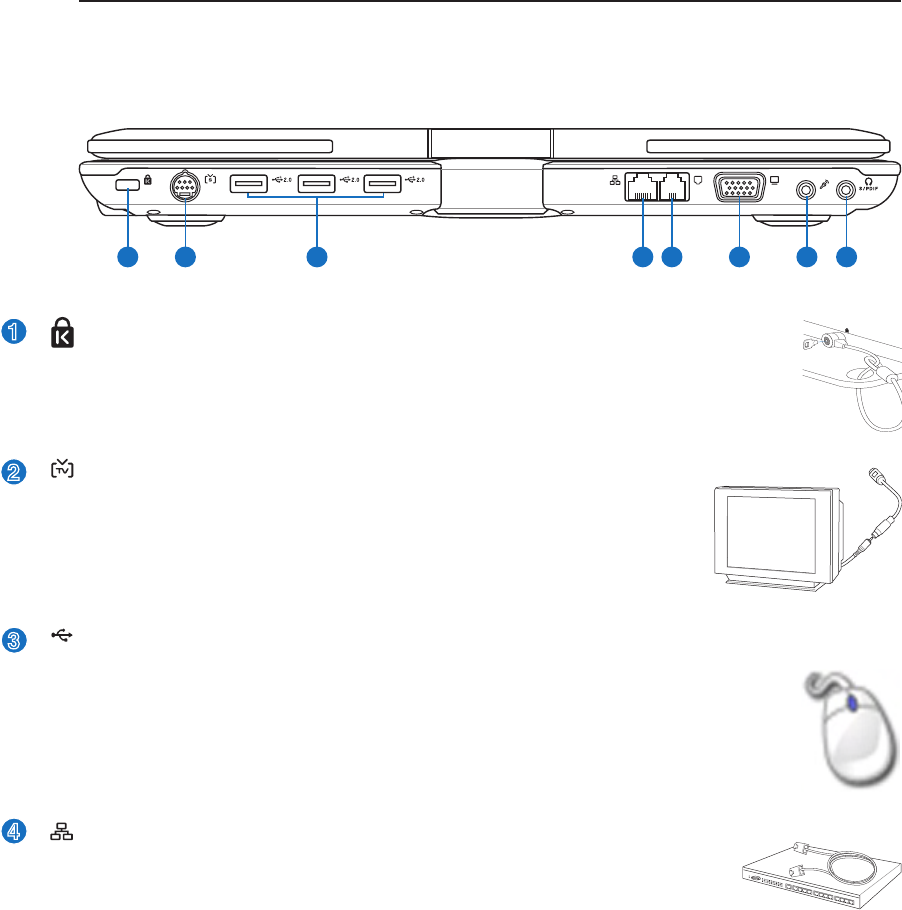
18
2 Knowing the Parts
2
1
4
Rear Side
Refer to the diagram below to identify the components on this side of the Notebook PC.
1 2 3 4 5 6 7 8
3
TV-Out Port
The TV-Out port is an S-Video connector that allows routing the Notebook
PC’s display to a television or video projection device. You can choose between
simultaneously or single display. Use an S-Video cable (not provided) for high
quality displays or use the provided RCA to S-Video adapter for standard video
devices. This port supports both NTSC and PAL formats.
2.0
USB Port (2.0/1.1)
The Universal Serial Bus is compatible with USB 2.0 or USB 1.1 devices such as keyboards,
pointing devices, cameras, hard disk drives, printers, and scanners connected in a series up
to 12Mbits/sec (USB 1.1) and 480Mbits/sec (USB 2.0). USB allows many devices to run
simultaneously on a single computer, with peripherals such as USB keyboards and some newer
monitors acting as additional plug-in sites or hubs. USB supports hot-swapping of devices so
that most peripherals can be connected or disconnected without restarting the computer.
LAN Port
The RJ-45 LAN port with eight pins is larger than the RJ-11 modem port and
supports a standard Ethernet cable for connection to a local network. The built-in
connector allows convenient use without additional adapters.
Kensington® Lock Port
The Kensington® lock port allows the Notebook PC to be secured using Kensington® com-
patible Notebook PC security products. These security products usually include a metal
cable and lock that prevent the Notebook PC to be removed from a xed object. Some
security products may also include a motion detector to sound an alarm when moved.
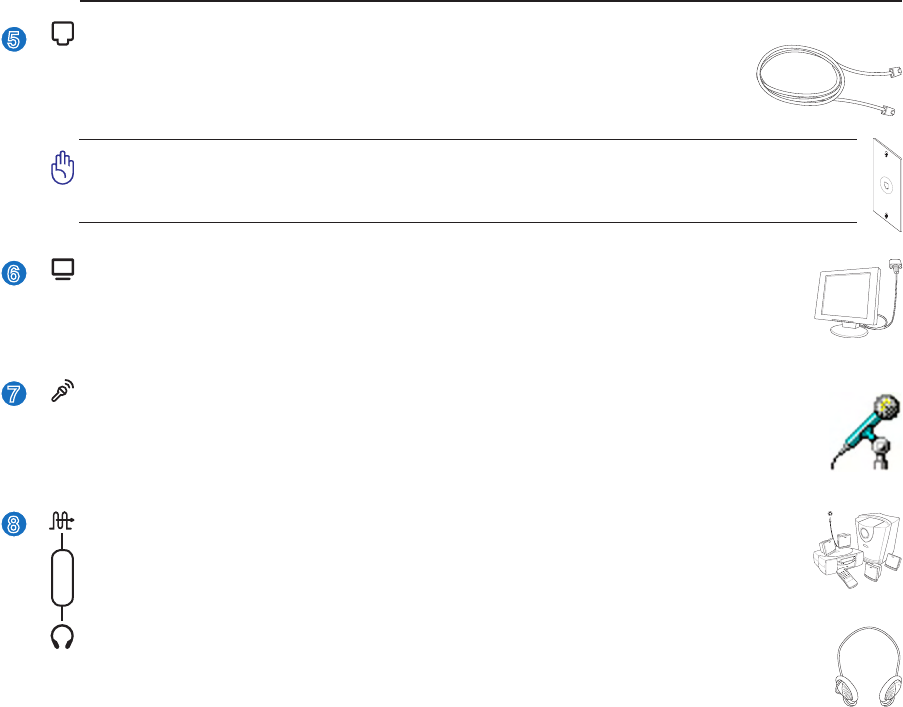
19
Knowing the Parts 2
6
7
8
5
Display (Monitor) Output
The 15-pin D-sub monitor port supports a standard VGA-compatible device such as a
monitor or projector to allow viewing on a larger external display.
SPDIF Output Jack
This jack provides connection to SPDIF (Sony/Philips Digital Interface) compliant devices
for digital audio output. Use this feature to turn the Notebook PC into a hi- home enter-
tainment system.
Headphone Output Jack
The stereo headphone jack (1/8 inch) is used to connect the Notebook PC’s audio out signal to
amplied speakers or headphones. Using this jack automatically disables the built-in speakers.
Combo
Microphone Input Jack
The mono microphone jack (1/8 inch) can be used to connect an external microphone or output
signals from audio devices. Using this jack automatically disables the built-in microphone.
Use this feature for video conferencing, voice narrations, or simple audio recordings.
Modem Port
The RJ-11 modem port with two pins is smaller than the RJ-45 LAN port and supports
a standard telephone cable. The internal modem supports up to 56K V.90 transfers.
The built-in connector allows convenient use without additional adapters.
IMPORTANT! The built-in modem does not support the voltage used in digital
phone systems. Do not connect the modem port to a digital phone system or else
damage will occur to the Notebook PC.
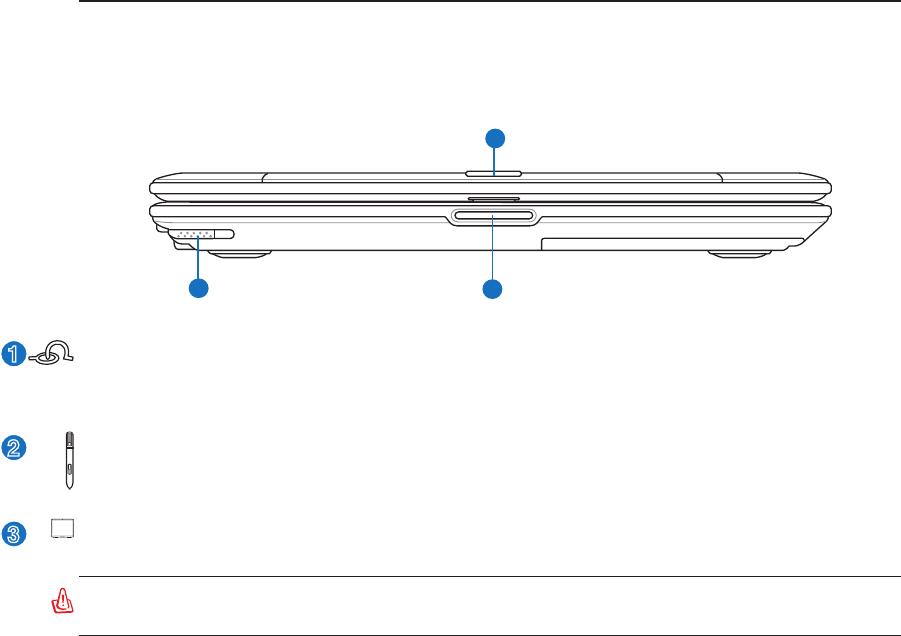
20
2 Knowing the Parts
Front Side
Refer to the diagram below to identify the components on this side of the Notebook PC.
1
23
WARNING! When opening, do not force the display panel down to the table or else
the hinges may break! Never lift the Notebook PC by the display panel!
Display Panel Button
Press the display panel button to open the display panel.
2
3
1
Display Panel Reversible Latch
One reversible latch on the front of the Notebook PC locks the display panel in the closed position or in
the tablet PC mode. The reversible latch must be manually switched from one mode to the other.
Tablet PC Pen
The tablet PC pen allows you to write or select items on the Notebook PC’s touch panel.
21
3. Getting Started
Using AC Power
Using Battery Power
Powering ON the Notebook PC
Checking Battery Power
Restarting or Rebooting
Powering OFF the Notebook PC
Special Keyboard Functions
Switches and Status Indicators
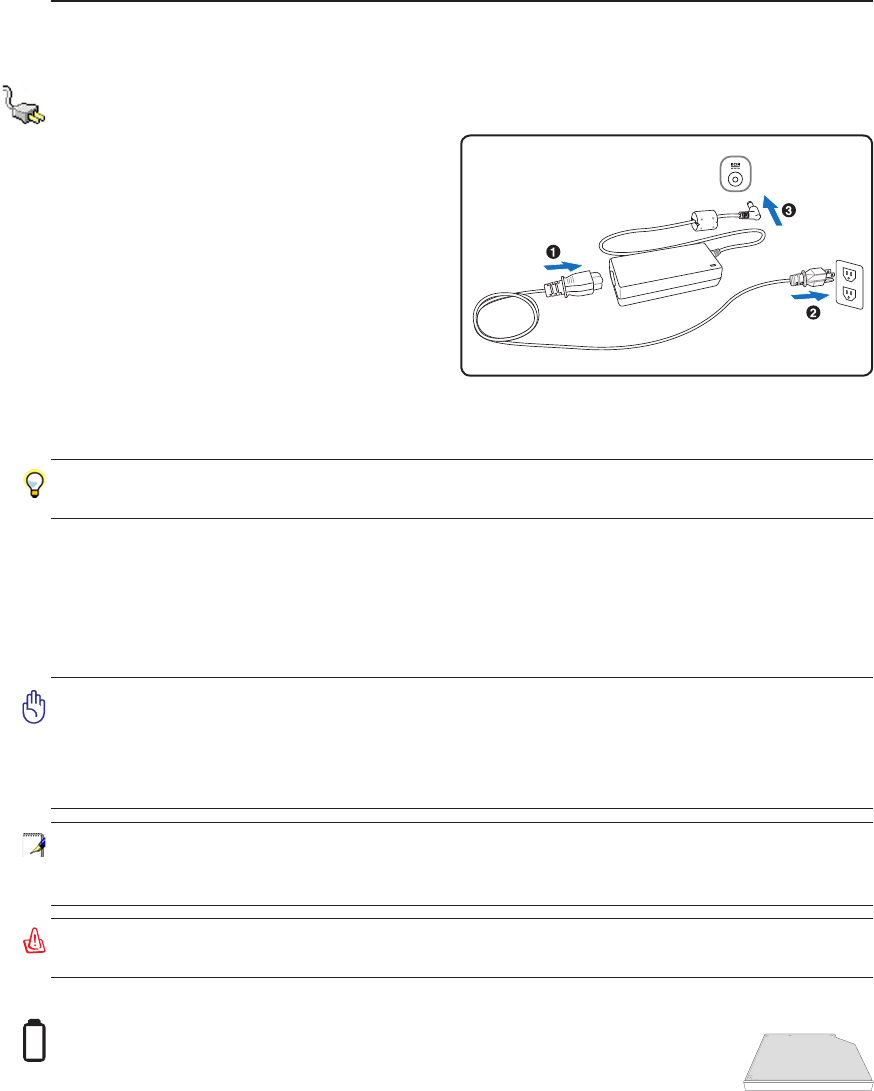
22
3 Getting Started
With the AC power cord connected to the AC-DC converter, connect the AC power cord to an AC outlet
(preferably with surge-protection) and then connect the DC plug to the Notebook PC. Connecting the
AC-DC adapter to the AC outlet rst allows you to test the AC outlet’s power and the AC-DC converter
itself for compatibility problems before connecting the DC power to the Notebook PC. The green power
LED on the adapter lights up if the power is within accepted ranges.
IMPORTANT! Damage may occur if you use a different adapter to power the Notebook
PC or use the Notebook PC’s adapter to power other electrical devices. If there is
smoke, burning scent, or extreme heat coming from the AC-DC adapter, seek servic-
ing. Seek servicing if you suspect a faulty AC-DC adapter. You may damage both your
battery pack(s) and the Notebook PC with a faulty AC-DC adapter.
TIP: You can buy travel kits for the Notebook PC that includes power and modem
adapters for almost every country.
NOTE: This Notebook PC may come with either a two or three-prong plug depending
on territory. If a three-prong plug is provided, you must use a grounded AC outlet or
use a properly grounded adapter to ensure safe operation of the Notebook PC.
WARNING! THE POWER ADAPTER MAY BECOME WARM TO HOT WHEN IN USE. BE
SURE NOT TO COVER THE ADAPTER AND KEEP IT AWAY FROM YOUR BODY.
Power System
Using AC Power
The Notebook PC power is comprised of two parts,
the power adapter and the battery power system.
The power adapter converts AC power from a wall
outlet to the DC power required by the Notebook
PC. Your Notebook PC comes with a universal
AC-DC adapter. That means that you may connect
the power cord to any 100V-120V as well as 220V-
240V outlets without setting switches or using
power converters. Different countries may require
that an adapter be used to connect the provided
US-standard AC power cord to a different standard.
Most hotels will provide universal outlets to sup-
port different power cords as well as voltages. It is always best to ask an experienced traveler about AC
outlet voltages when bringing power adapters to another country.
Second Battery Pack
This Notebook PC features a module bay to accept a second battery pack for extended
use without AC power.
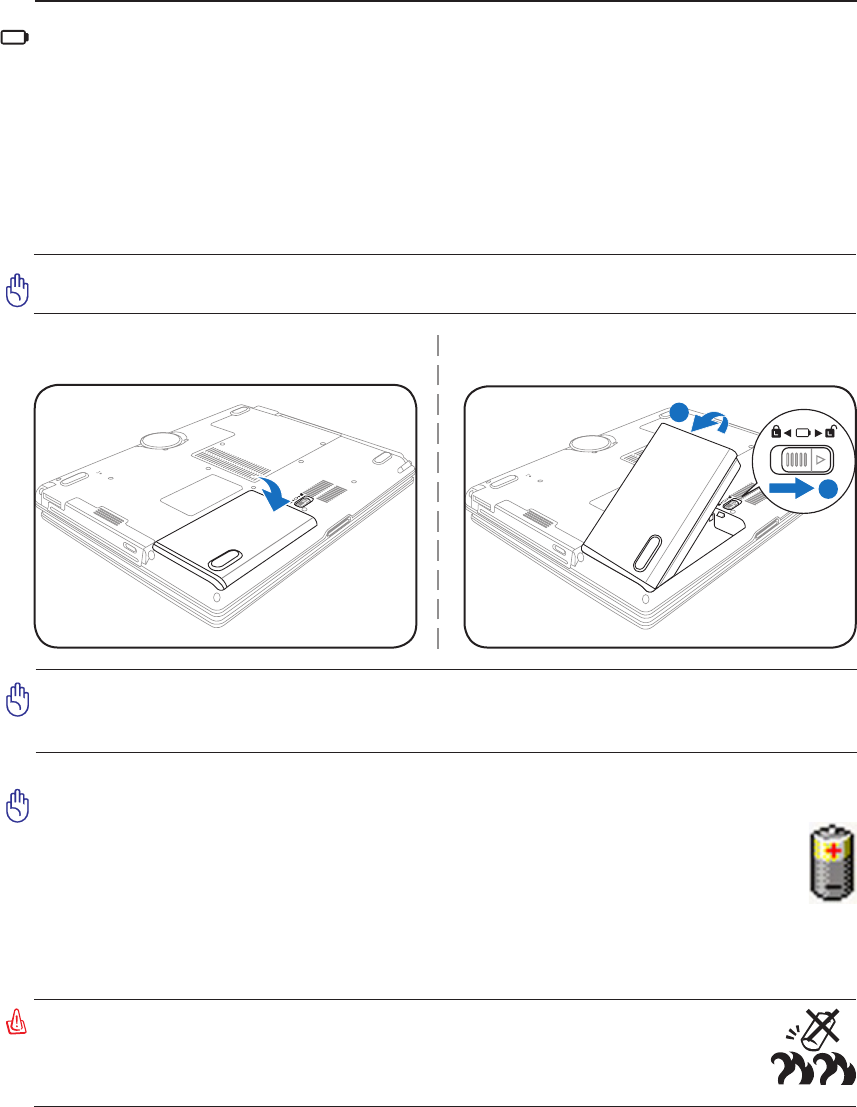
23
Getting Started 3
IMPORTANT! Never attempt to remove the battery pack while the Notebook PC is
turned ON, as this may result in the loss of working data.
IMPORTANT! Only use battery packs and power adapters supplied with this Notebook
PC or specically approved by the manufacturer or retailer for use with this model or
else damage may occur to the Notebook PC.
1
2
To install the battery pack: To remove the battery pack:
Using Battery Power
The Notebook PC is designed to work with a removable battery pack. The battery pack consists of a set
of battery cells housed together. A fully charged pack will provide several hours of battery life, which
can be further extended by using power management features through the BIOS setup. Additional battery
packs are optional and can be purchased separately through a Notebook PC retailer.
Installing and Removing the Battery Pack
Your Notebook PC may or may not have its battery pack installed. If your Notebook PC does not have
its battery pack installed, use the following procedures to install the battery pack.
Battery Care
The Notebook PC’s battery pack, like all rechargeable batteries, has a limit on the number times
it can be recharged. The battery pack’s useful life will depend on your environment temperature,
humidity, and how your Notebook PC is used. It is ideal that the battery be used in a temperature
range between 5˚C and 35˚C (41˚F and 95˚F). You must also take into account that the Notebook
PC’s internal temperature is higher than the outside temperature. Any temperatures above or below
this range will shorten the life of the battery. But in any case, the battery pack’s usage time will eventu-
ally decrease and a new battery pack must be purchased from an authorized dealer for this Notebook PC.
Because batteries also have a shelf life, it is not recommended to buy extras for storing.
WARNING! For safety reasons, DO NOT throw the battery in re, DO NOT
short circuit the contacts, and DO NOT disassemble the battery. If there is
any abnormal operation or damage to the battery pack caused by impact,
turn OFF the Notebook PC and contact an authorized service center.
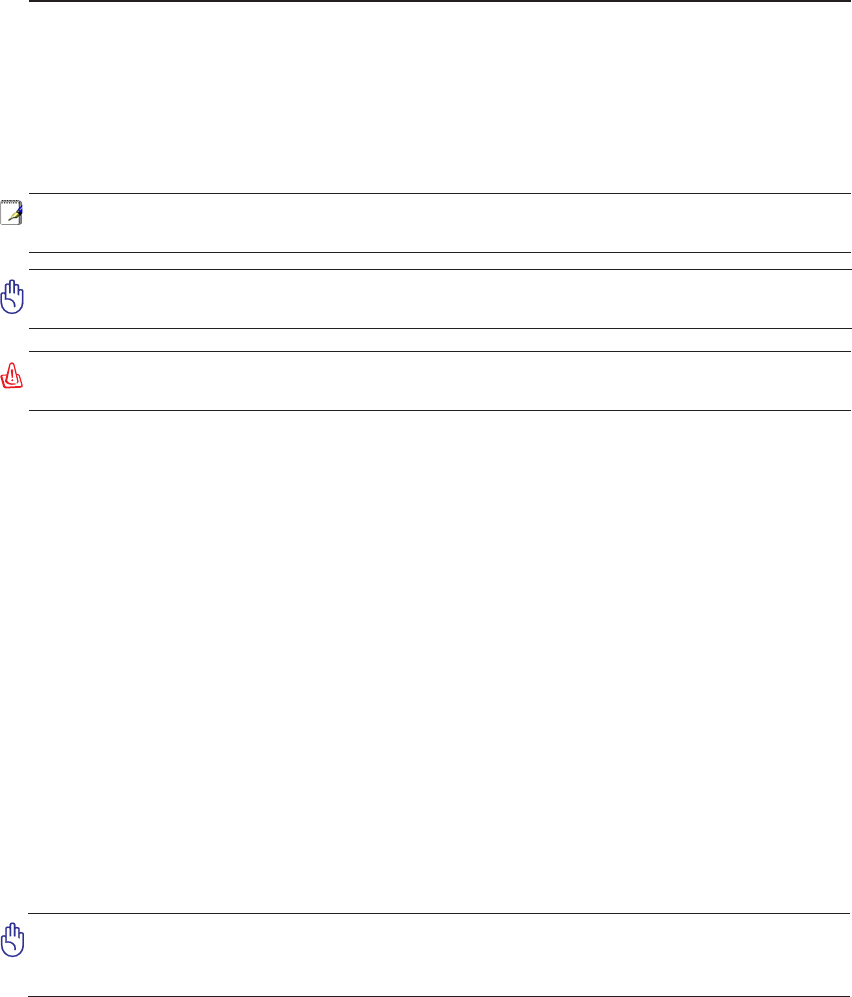
24
3 Getting Started
Powering ON the Notebook PC
The Notebook PC’s power-ON message appears on the screen when you turn it ON. If necessary, you
may adjust the brightness by using the hot keys. If you need to run the BIOS Setup to set or modify the
system conguration, press [F2] upon bootup to enter the BIOS Setup. If you press [Tab] during the
splash screen, standard boot information such as the BIOS version can be seen. Press [ESC] and you will
be presented with a boot menu with selections to boot from your available drives.
IMPORTANT! To protect the hard disk drive, always wait at least 5 seconds after turn-
ing OFF your Notebook PC before turning it back ON.
NOTE: Before bootup, the display panel ashes when the power is turned ON. This is
part of the Notebook PC’s test routine and is not a problem with the display.
WARNING! DO NOT carry or cover a Notebook PC that is powered ON with any materi-
als that will reduce air circulation such as a carrying bag.
The Power-On Self Test (POST)
When you turn ON the Notebook PC, it will rst run through a series of software-controlled diagnos-
tic tests called the Power-On Self Test (POST). The software that controls the POST is installed as a
permanent part of the Notebook PC’s architecture. The POST includes a record of the Notebook PC’s
hardware conguration, which is used to make a diagnostic check of the system. This record is created
by using the BIOS Setup program. If the POST discovers a difference between the record and the exist-
ing hardware, it will display a message on the screen prompting you to correct the conict by running
BIOS Setup. In most cases the record should be correct when you receive the Notebook PC. When the
test is nished, you may get a message reporting “No operating system found” if the hard disk was not
preloaded with an operating system. This indicates that the hard disk is correctly detected and ready for
the installation of a new operating system.
The S.M.A.R.T. (Self Monitoring and Reporting Technology) checks the hard disk drive during POST and
gives a warning message if the hard disk drive requires servicing. If any critical hard disk drive warning
is given during bootup, backup your data immediately and run Windows disk checking program. To run
Window’s disk checking program: (1) right-click any hard disk drive icon in “My Computer”, (2) choose
Properties, (3) click the Tools tab, (4) click Check Now, (5) select a hard disk drive, (6) select Thorough to
also check for physical damages, and (7) click Start. Third party disk utilities such as Symantec’s Norton
Disk Doctor can also perform the same functions but with greater ease and more features.
IMPORTANT! If warnings are still given during bootup after running a software disk
checking utility, you should take your Notebook PC in for servicing. Continued use
may result in data loss.
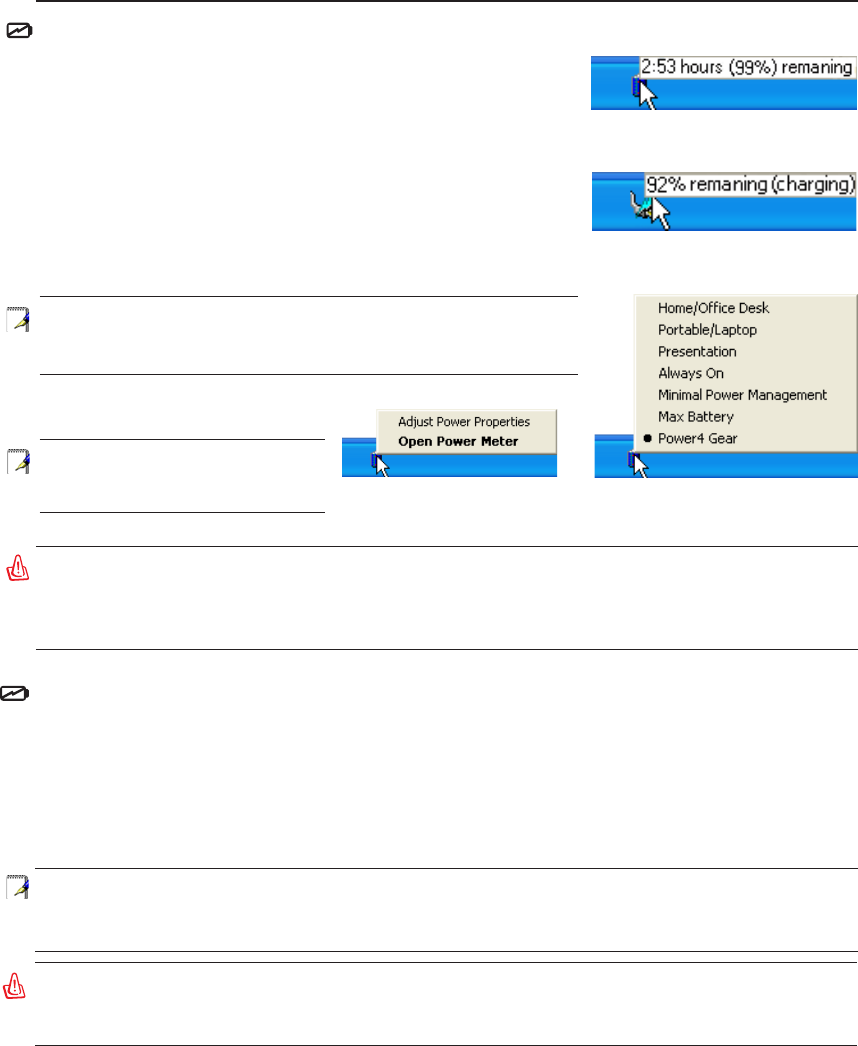
25
Getting Started 3
Checking Battery Power
The battery system implements the Smart Battery standard under
the Windows environment, which allows the battery to accurately
report the amount of charge left in the battery. A fully-charged battery
pack provides the Notebook PC a few hours of working power. But
the actual gure varies depending on how you use the power saving
features, your general work habits, the CPU, system memory size,
and the size of the display panel.
To check the remaining battery power, move your cursor over the
power icon. The power icon is a “battery” when not using AC power
and a “plug” when using AC power. Double click on the icon for
more information and settings.
NOTE: You will be warned when battery power is low. If you
continue to ignore the low battery warnings, the Notebook PC
eventually enters suspend mode (Windows default uses STR).
WARNING! Suspend-to-RAM (STR) does not last long when the battery power is depleted.
Suspend-to-Disk (STD) is not the same as power OFF. STD requires a small amount of
power and will fail if no power is available due to complete battery depletion or no power
supply (e.g. removing both the power adapter and battery pack).
Right-click the battery icon for
sub-menus. Left-click the battery icon for power
management settings.
Note: Screen captures shown here
are examples only and may not re-
ect what you see in your system.
Move your mouse over the battery icon
for remaining power information.
When the AC power is connected,
charging status will be shown.
Charging the Battery Pack
Before you use your Notebook PC on the road, you will have to charge the battery pack. The battery pack
begins to charge as soon as the Notebook PC is connected to external power using the power adapter.
Fully charge the battery pack before using it for the rst time. A new battery pack must completely charge
before the Notebook PC is disconnected from external power. It takes a few hours to fully charge the
battery when the Notebook PC is turned OFF and may take twice the time when the Notebook PC is
turned ON. The battery charge light turns OFF when the battery pack is charged.
WARNING! Do not leave the battery pack discharged. The battery pack will discharge
over time. If not using a battery pack, it must continued to be charged every three
months to extend recovery capacity or else it may fail to charge in the future.
NOTE: The battery stops charging if the temperature is too high or the battery voltage
is too high. BIOS provides a smart battery refreshing function. If the battery calibration
process fails, stop charging and contact an authorized service center.
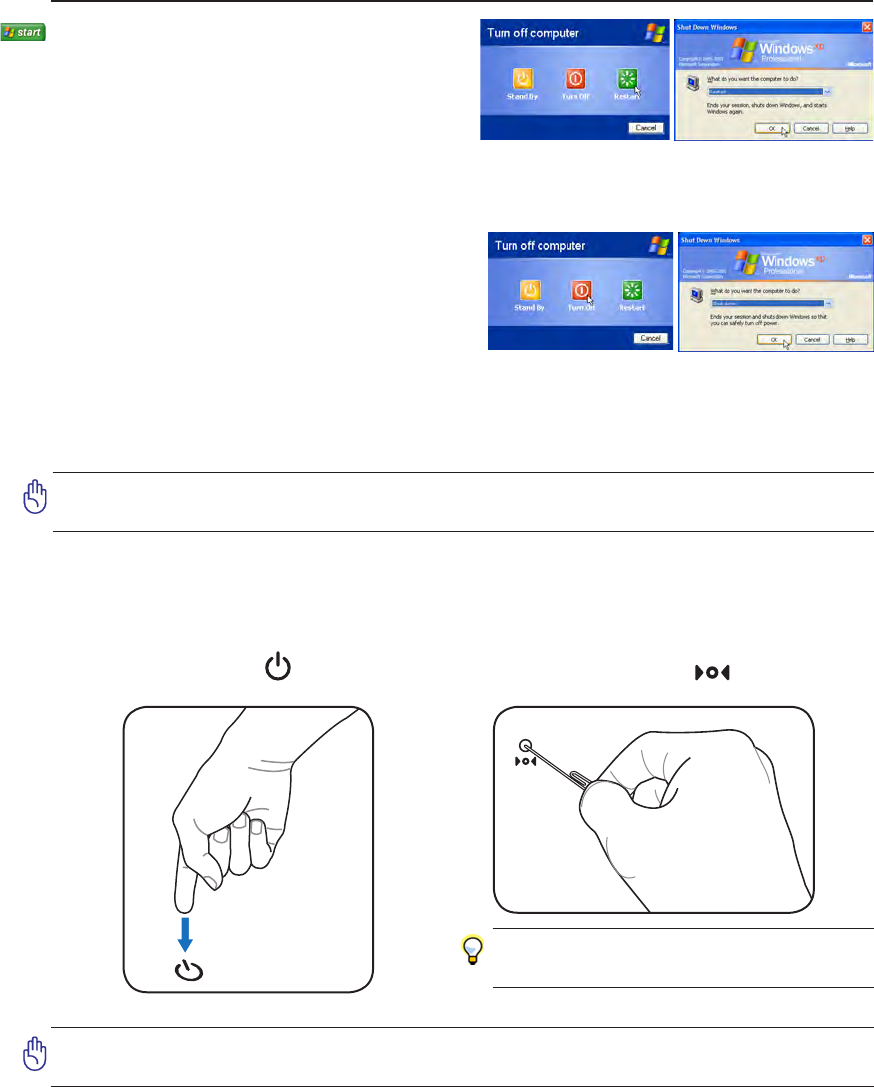
26
3 Getting Started
Restarting or Rebooting
After making changes to your operating system,
you may be prompted to restart the system. Some
installation processes will provide a dialog box to
allow restart. To restart the system manually, click
Windows Start button and select Shut Down and
then choose Restart.
Powering OFF
In Windows XP, power OFF the Notebook PC by
clicking Windows Start button and select Shut Down
and then choose Turn off (or Shut down). For oper-
ating systems without proper power management
(DOS, Windows NT), you must close all applications
and exit operating systems and then power OFF by holding the power switch for 2 seconds (as opposed
to 1 second to power ON). Holding the power switch for 2 seconds is necessary in order to prevent ac-
cidental power-OFFs.
IMPORTANT! To protect the hard drive, wait at least 5 seconds after turning OFF your
Notebook PC before turning it back ON.
(Screens are different depending on security settings.)
Emergency Shutdown
In case your operating system cannot properly turn OFF or restart, there are two additional ways to
shutdown your Notebook PC:
(1) Hold the power button over 4 seconds, or (2) Press the shutdown button .
IMPORTANT! Do not use emergency shutdown while data is being written; doing so
can result in loss or destruction of your data.
TIP: Use a straightened paper clip to
press the shutdown button.
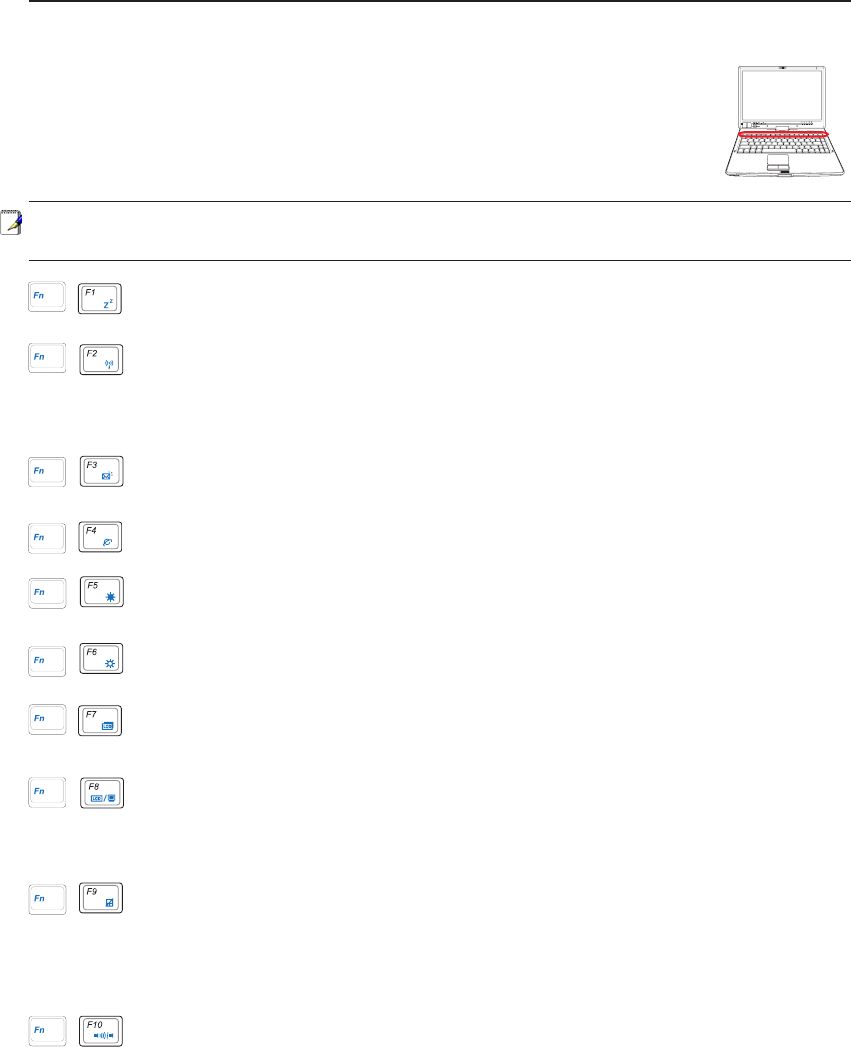
27
Getting Started 3
Special Keyboard Functions
Colored Hot Keys
The following denes the colored hot keys on the Notebook PC’s keyboard. The colored
commands can only be accessed by rst pressing and holding the function key while
pressing a key with a colored command.
LCD/Monitor Icons (F8): Toggles between the Notebook PC’s LCD display and an external
monitor in this series: Notebook PC LCD -> External Monitor -> Both. (This function does
not work in 256 Colors, select High Color in Display Property Settings.) IMPORTANT:
Connect an external monitor before booting up the Notebook PC.
LCD Icon (F7): Toggles the display panel ON and OFF. This also stretches your screen
area (on certain models) to ll the entire display when using low resolution modes.
Open Sun Icon (F6):
Increases the display brightness
Filled Sun Icon (F5):
Decreases the display brightness
“Zz” Icon (F1): Places the Notebook PC in suspend mode (either Save-to-RAM or Save-
to-Disk depending on sleep button setting in power management setup).
“e” Icon (F4): Pressing this button will launch your Internet browser application while
Windows is running.
Envelope Icon (F3): Pressing this button will launch your Email application while Win-
dows is running.
NOTE: The Hot Key locations on the function keys may vary depending on model but the
functions should remain the same. Follow the icons instead of the function keys.
Radio Tower (F2): Wireless Models Only: Toggles the internal wireless LAN or Blue-
tooth (on selected models) ON or OFF with an on-screen-display. When enabled, the cor-
responding wireless indicator will light. Windows software settings are necessary to use
the wireless LAN or Bluetooth.
Speaker Icons (F10):
Toggles the speakers ON and OFF (only in Windows OS)
Crossed-out Touchpad (F9): Toggles the built-in touchpad LOCKED (disabled) and UN-
LOCKED (enabled). Locking the touchpad will prevent you from accidentally moving the
cursor while typing and is best used with an external pointing device such as a mouse. Note:
An indicator between the touchpad buttons will light when the touchpad is UNLOCKED
(enabled) and not light when the touchpad is LOCKED (disabled).
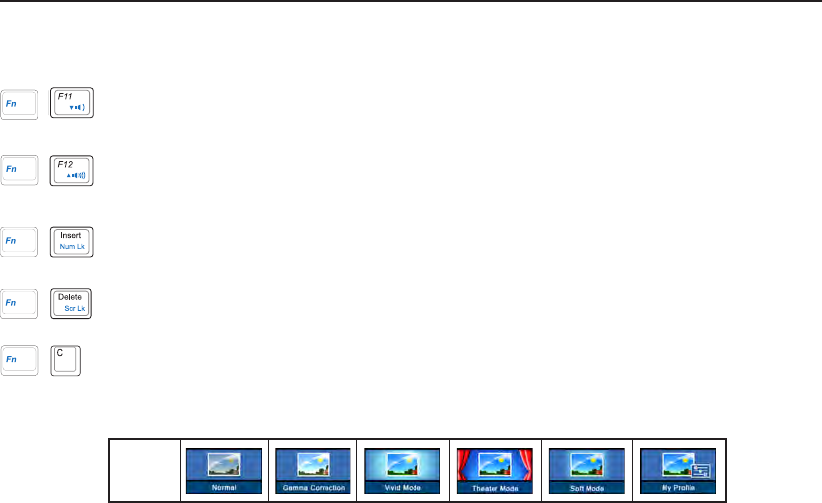
28
3 Getting Started
Scr Lk (Del): Toggles the “Scroll Lock” ON and OFF. Allows you to use a larger portion
of the keyboard for cell navigation.
Num Lk (Ins): Toggles the numeric keypad (number lock) ON and OFF. Allows you to
use a larger portion of the keyboard for number entering.
Colored Hot Keys (Cont.)
Fn+C: Toggles “Splendid Video Intelligent Technology” function ON and OFF. This al-
lows switching between different display color enhancement modes in order to improve
contrast, brightness, skin tone, and color saturation for red, green, and blue independently.
You can see the current mode through the on-screen display (OSD).
OSD
Icons
Speaker Down Icon (F11):
Decreases the speaker volume (only in Windows OS)
Speaker Up Icon (F12):
Increases the speaker volume (only in Windows OS)
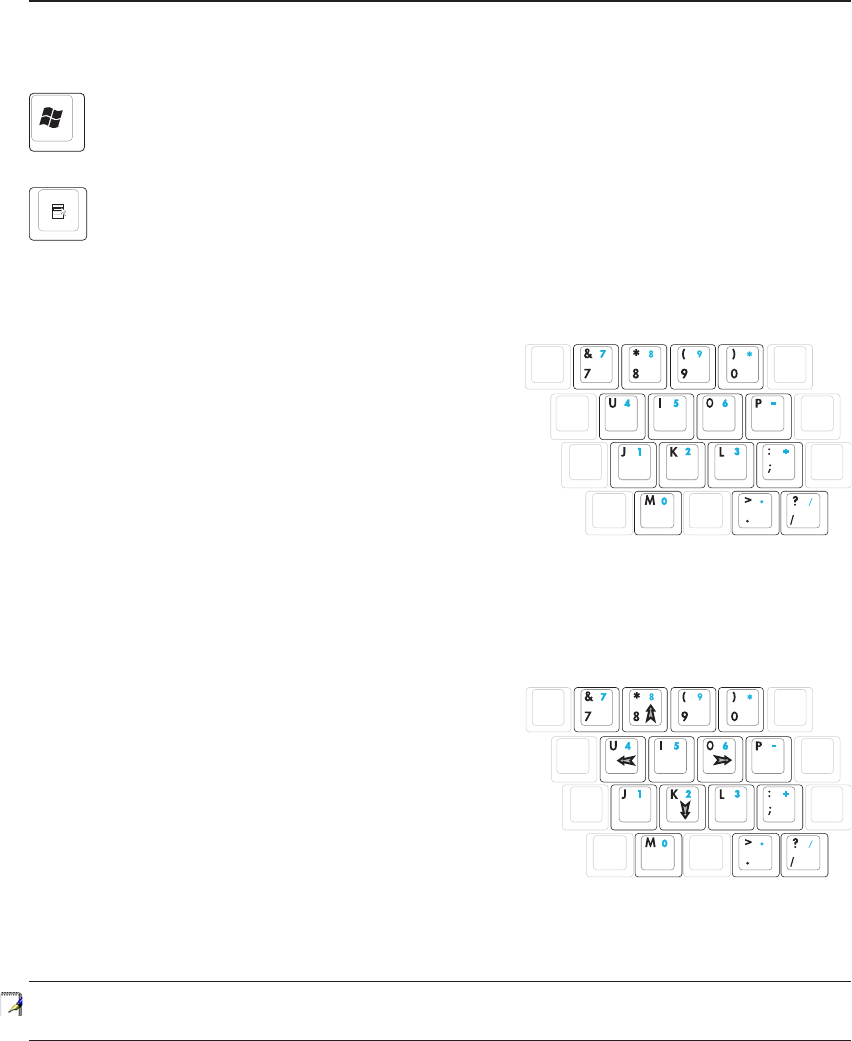
29
Getting Started 3
Microsoft Windows Keys
There are two special Windows keys on the keyboard as described below.
The key with the Windows Logo activates the Start menu located at the bottom left of the Win-
dows desktop.
The other key, that looks like a Windows menu with a small cursor, activates the properties menu
and is equivalent to pressing the right mouse button on a Windows object.
Keyboard as a Numeric Keypad
The numeric keypad is embedded in the keyboard and
consists of 15 keys that make number intensive input more
convenient. These dual-purpose keys are labeled in orange on
the key caps. Numeric assignments are located at the upper
right hand corner of each key as shown in the gure. When
the numeric keypad is engaged by pressing [Fn][Ins/Num
LK], the number lock LED lights up. If an external keyboard
is connected, pressing the [Ins/Num LK] on the external
keyboard enables/disables the NumLock on both keyboards
simultaneously. To disable the numeric keypad while keeping
the keypad on an external keyboard activated, press the [Fn][Ins/Num LK] keys on the Notebook PC.
Keyboard as Cursors
The keyboard can be used as cursors while Number Lock is
ON or OFF in order to increase navigation ease while entering
numeric data in spreadsheets or similar applications.
With Number Lock OFF, press [Fn] and one of the cursor
keys shown below. For example [Fn][8] for up, [Fn][K] for
down, [Fn][U] for left, and [Fn][O] for right.
With Number Lock ON, use [Shift] and one of the cursor
keys shown below. For example [Shift][8] for up, [Shift][K]
for down, [Shift][U] for left, and [Shift][O] for right.
NOTE: The arrow symbols are illustrated here for your reference. They are not labeled
on the keyboard as shown here.
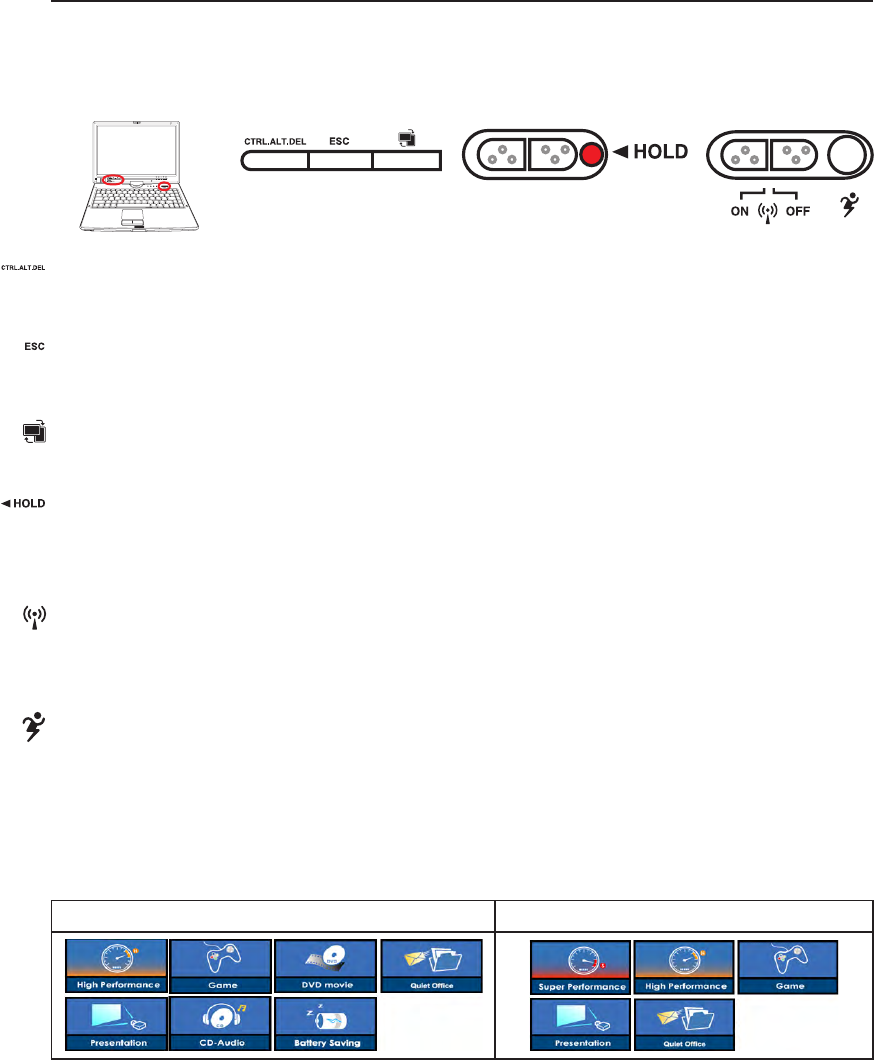
30
3 Getting Started
Switches
Switches and Status Indicators
Wireless Switch
Enables or disables the built-in wireless LAN. When enabled, the wireless status indicator will light.
(Windows software settings are necessary before use.)
Battery Mode AC Mode
Power4 Gear+ Key
The Power4 Gear+ button toggles power savings between various power saving modes. The power saving
modes control many aspects of the Notebook PC to maximize performance versus battery time.
When you are using an AC power adapter, Power4 Gear+ will switch between three modes in the AC
power mode segment. When you remove the AC adapter, Power4 Gear+ will switch between seven
modes in the battery (DC) mode segment. When you remove or apply the AC adapter, Power4 Gear+
will automatically shift you up or down into the proper mode segment (AC or DC).
CTRL.ALT.DEL Key
Pressing this key emulates the key combinations on the keyboard. Used for logging into Windows.
Rotate Screen Key
For use with tablet PC mode. Press once to rotate the screen clock-wise.
Hold Key
For use with tablet PC mode. When enabled, the keys on the display panel will be disabled in case they
are accidentally pressed while using the tablet PC pen on the display panel.
ESC Key
Pressing this key here is the same as on the keyboard.
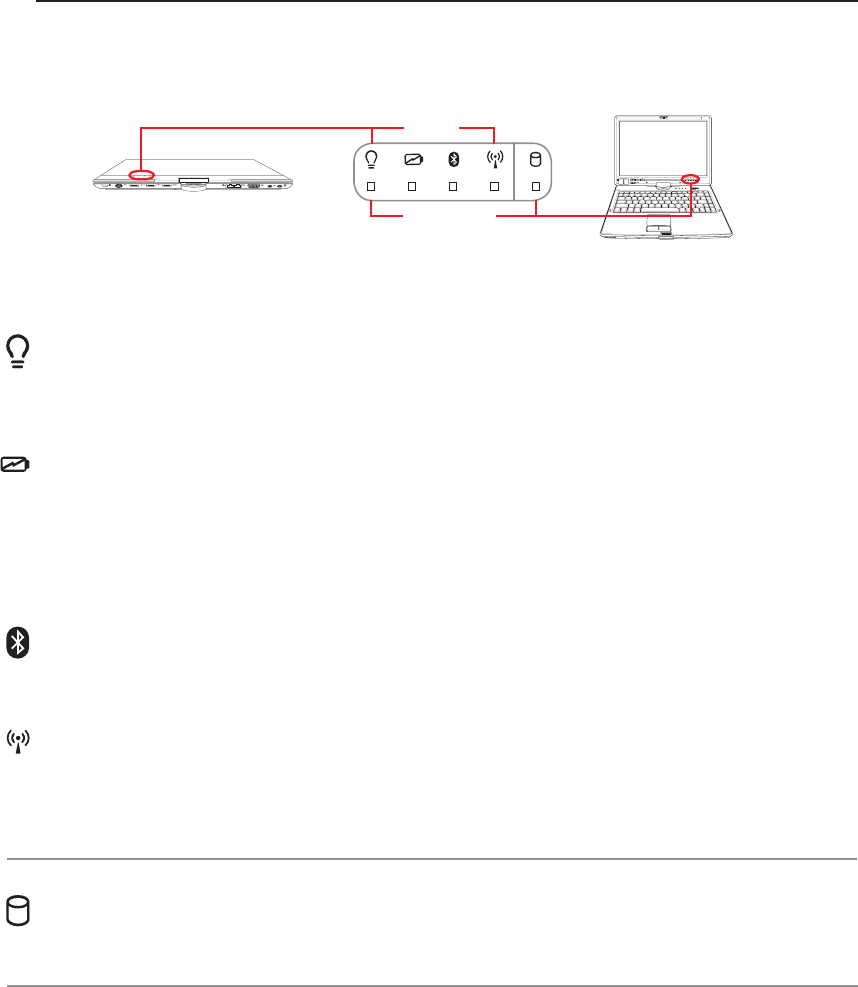
31
Getting Started 3
Status Indicators
Drive Activity Indicator
Indicates that the Notebook PC is accessing one or more storage device(s) such as the hard disk. The
light ashes proportional to the access time.
Bluetooth Indicator
This is only applicable on models with internal Bluetooth (BT). This indicator will light to show that the
Notebook PC’s built-in BT function is activated.
Wireless Indicator
This is only applicable on models with built-in wireless LAN and/or built-in Bluetooth. When the built-in
wireless LAN and/or built-in Bluetooth is enabled, this indicator will light. (Windows software settings
are necessary.)
Power Indicator
The power indicator lights when the Notebook PC is turned ON and blinks slowly when the Notebook
PC is in the Suspend-to-RAM (Standby) mode. This indicator is OFF when the Notebook PC is turned
OFF or in the Suspend-to-Disk (Hibernation) mode.
Battery Charge Indicator
The battery charge indicator is an LED that shows the status of the battery’s power as follows:
ON: The Notebook PC’s battery is charging when AC power is connected.
OFF: The Notebook PC’s battery is charged or completely drained.
Blinking: Battery power is less than 10% and the AC power is not connected.
Outside
Display panel
Display panel and outside
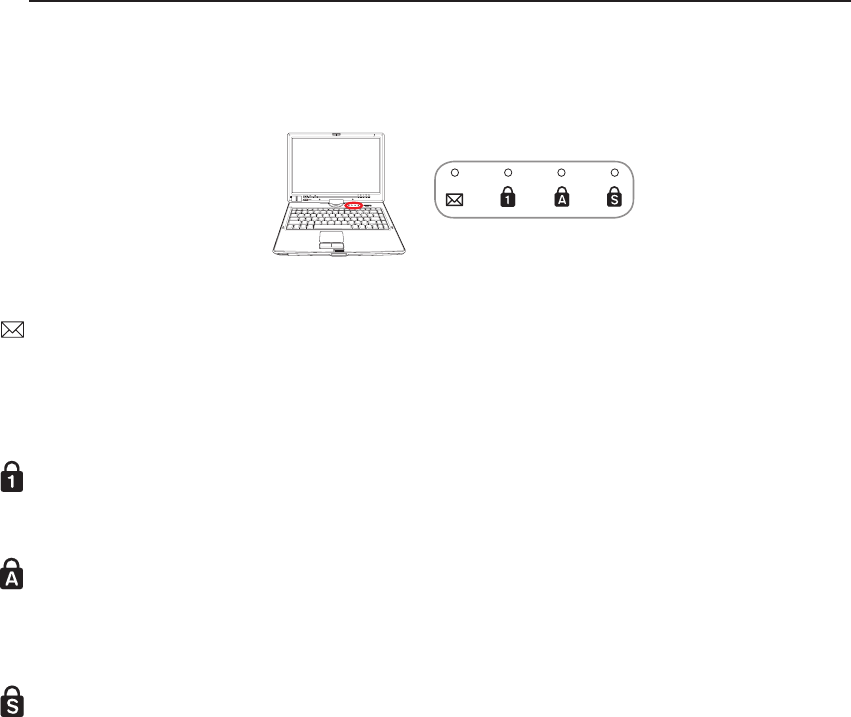
32
3 Getting Started
Scroll Lock Indicator
Indicates that scroll lock [Scr Lk] is activated when lit. Scroll lock allows some of the keyboard letters
to act as direction keys in order to allow easier navigation when only a part of the keyboard is required,
such as for playing games.
Email Indicator
Flashes when there is one or more new email(s) in your email program’s inbox. This function requires
software setup and may not be currently congured on your Notebook PC. This function is designed for
Microsoft email software only and may not work with email software from other companies.
Number Lock Indicator
Indicates that number lock [Num Lk] is activated when lighted. Number lock allows some of the key-
board letters to act as numbers for easier numeric data input.
Capital Lock Indicator
Indicates that capital lock [Caps Lock] is activated when lighted. Capital lock allows some of the key-
board letters to type using capitalized letters (e.g. A, B, C). When the capital lock light is OFF, the typed
letters will be in the lower case form (e.g. a,b,c).
Top of keyboard
Status Indicators (Cont.)
Top of keyboard
33
4. Using the Notebook PC
Operating System
Pointing Device
Storage Devices
ExpressCard Slot
Optical Drive
Hard Disk Drive
Connections
Modem Connection
Network Connection
Wireless LAN Connection
Bluetooth Wireless Connection
Power Management Modes
Tablet PC Mode
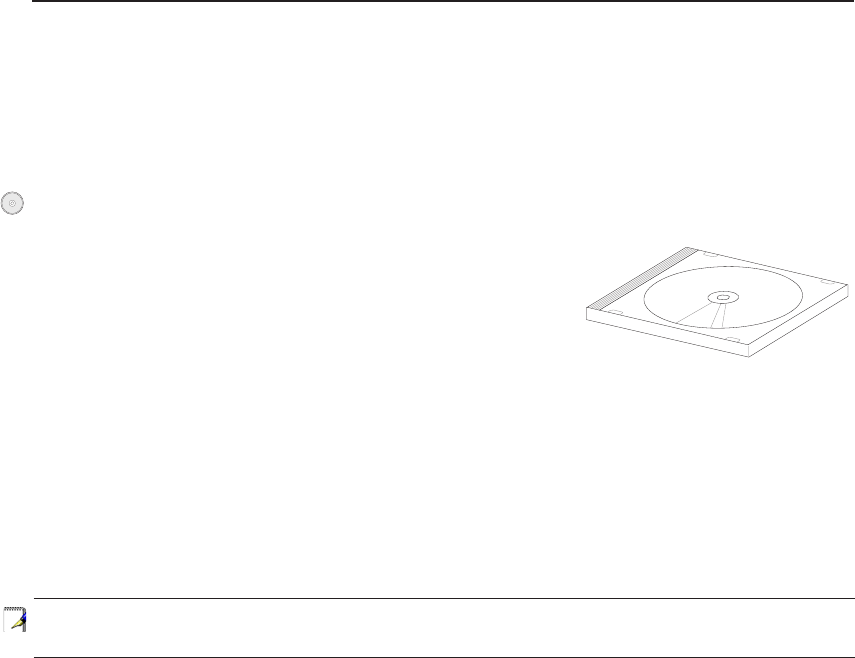
34
4 Using the Notebook PC
Operating System
This Notebook PC may offer (depending on territory) its customers the choice of a pre-installed operat-
ing system such as Microsoft Windows XP. The choices and languages will depend on the territory.
The levels of hardware and software support may vary depending on the installed operating system. The
stability and compatibility of other operating systems cannot be guaranteed.
Support Software
This Notebook PC comes with a support CD that provides BIOS, drivers and applications to enable
hardware features, extend functionality, help manage your Note-
book PC, or add functionality not provided by the native operating
system. If updates or replacement of the support CD is necessary,
contact your dealer for web sites to download individual software
drivers and utilities.
The support CD contains all drivers, utilities and software for all popular operating systems including
those that have been pre-installed. The support CD does not include the operating system itself. The
support CD is necessary even if your Notebook PC came pre-congured in order to provide additional
software not included as part of the factory pre-install.
A recovery CD is optional and includes an image of the original operating system installed on the hard
drive at the factory. The recovery CD provides a comprehensive recovery solution that quickly restores
the Notebook PC’s operating system to its original working state provided that your hard disk drive is
in good working order. Contact your retailer if you require such a solution.
Note: Some of the Notebook PC’s components and features may not work until the
device drivers and utilities are installed.
OS
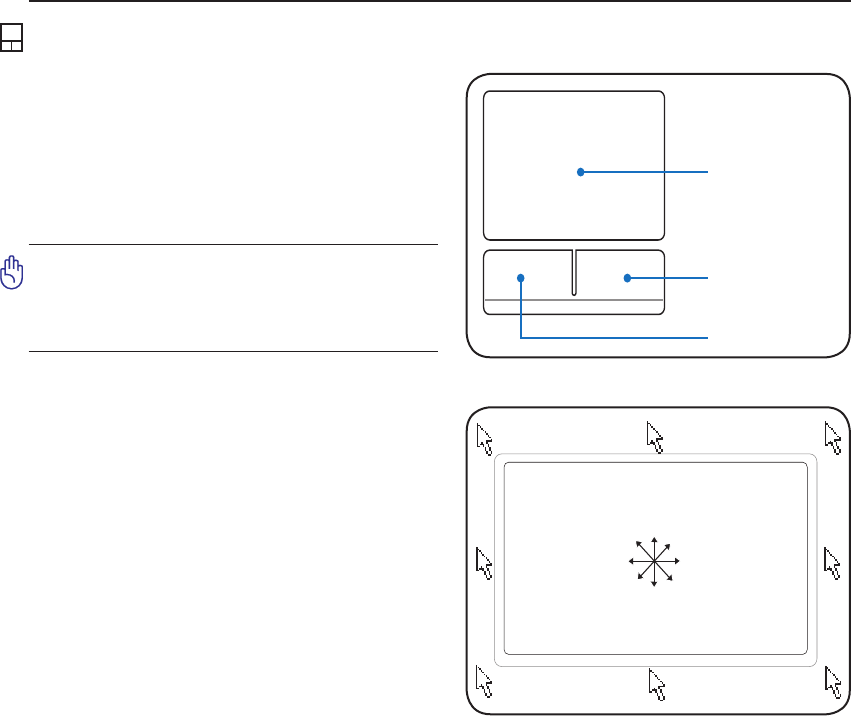
35
Using the Notebook PC 4
IMPORTANT! Do not use any objects in
place of your nger to operate the touch-
pad or else damage may occur to the
touchpad’s surface.
Pointing Device
The Notebook PC’s integrated touchpad pointing
device is fully compatible with all two/three-but-
ton and scrolling knob PS/2 mice. The touchpad is
pressure sensitive and contains no moving parts;
therefore, mechanical failures can be avoided. A
device driver is still required for working with some
application software.
Using the Touchpad
Light pressure with the tip of your nger is all that
is required to operate the touchpad. Because the
touchpad is electrostatic sensitive, objects cannot
be used in place of your ngers. The touchpad’s
primary function is to move the cursor around or
select items displayed on the screen with the use of
your ngertip instead of a standard desktop mouse.
The following illustrations demonstrate proper use
of the touchpad.
Moving The Cursor
Place your nger in the center of the touchpad and
slide in a direction to move the cursor.
Slide nger
forward
Slide nger
left
Slide nger
backward
Slide nger
right
Cursor
Movement
Right Click
Left Click
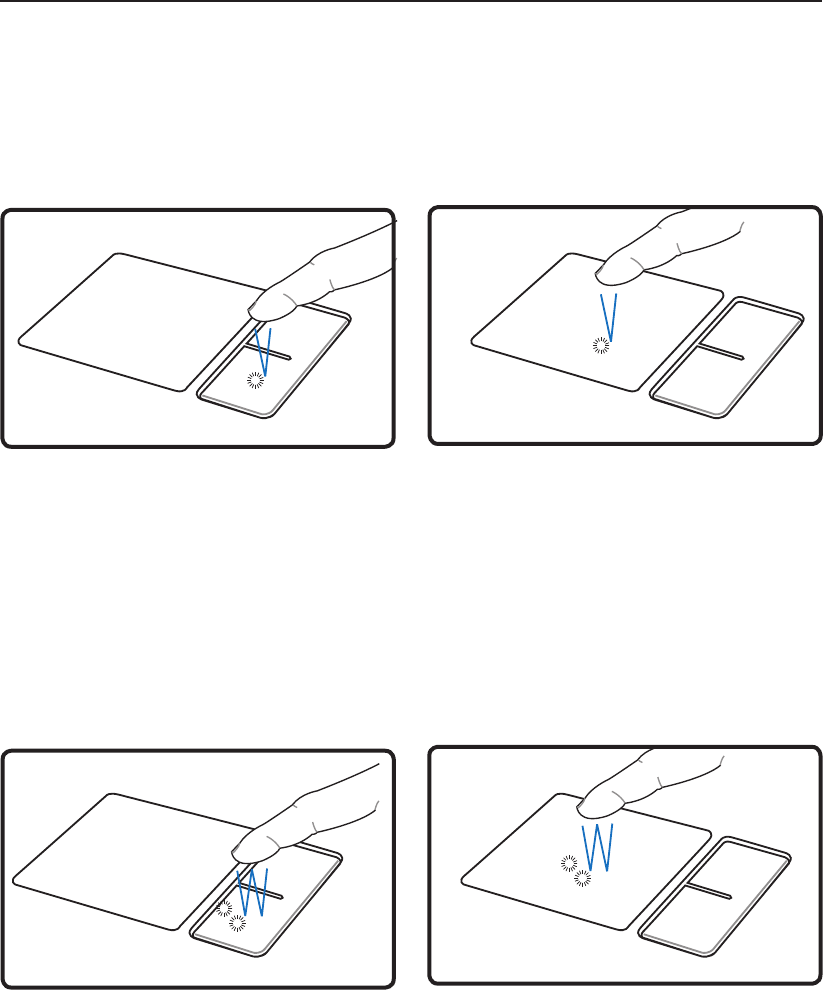
36
4 Using the Notebook PC
Double-clicking/Double-tapping - This is a common skill for launching a program directly from the
corresponding icon you select. Move the cursor over the icon you wish to execute, press the left button or
tap the pad twice in rapid succession, and the system launches the corresponding program. If the interval
between the clicks or taps is too long, the operation will not be executed. You can set the double-click speed
using the Windows Control Panel “Mouse.” The following 2 examples produce the same results.
(press the left button twice and release) (lightly but rapidly strike the touchpad twice)
(press the left cursor button and release) (lightly but rapidly strike the touchpad)
Clicking/Tapping - With the cursor over an item, press the left button or use your ngertip to touch the
touchpad lightly, keeping your nger on the touchpad until the item is selected. The selected item will
change color. The following 2 examples produce the same results.
Clicking Tapping
Double-Clicking Double-Tapping
Touchpad Usage Illustrations
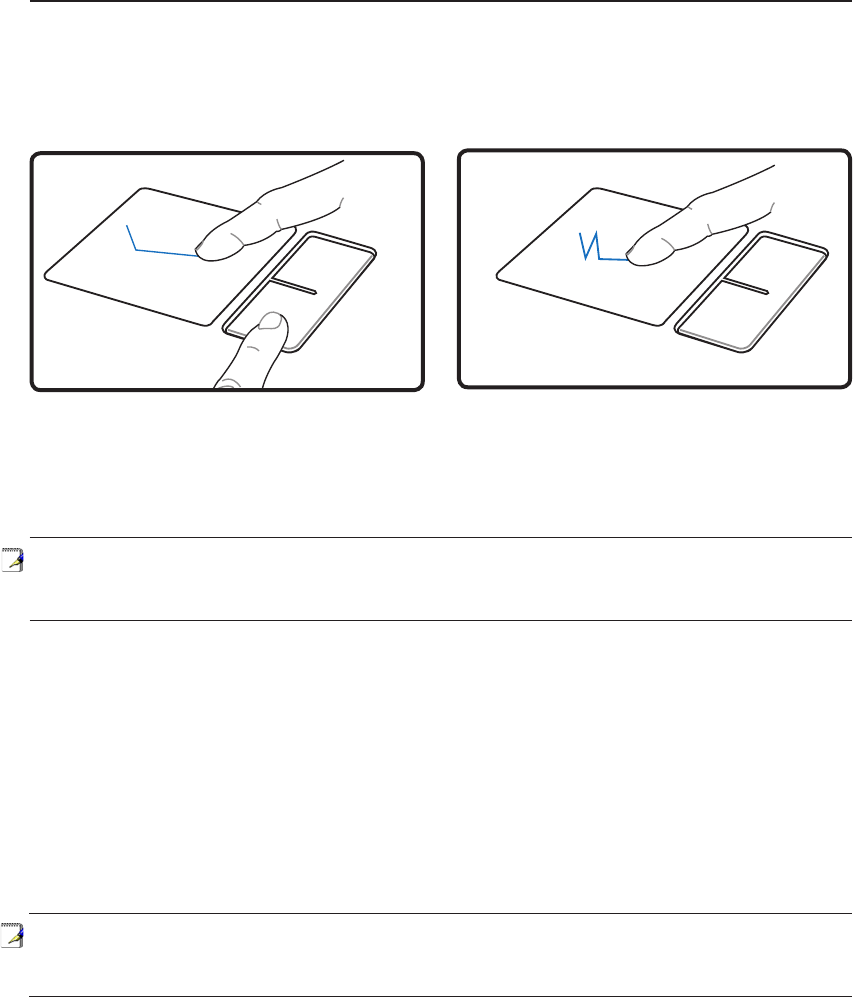
37
Using the Notebook PC 4
Caring for the Touchpad
The touchpad is pressure sensitive. If not properly cared for, it can be easily damaged. Take note of the
following precautions.
• Make sure the touchpad does not come into contact with dirt, liquids or grease.
• Do not touch the touchpad if your ngers are dirty or wet.
• Do not rest heavy objects on the touchpad or the touchpad buttons.
• Do not scratch the touchpad with your nger nails or any hard objects.
Dragging - Dragging means to pick up an item and place it anywhere on the screen you wish. You can
move the cursor over the item you select, and while keeping the left button depressed, moving the cursor
to the desired location, then release the button. Or, you can simply double-tap on the item and hold while
dragging the item with your ngertip. The following illustrations produce the same results.
(hold left button and slide nger on touchpad) (lightly strike the touchpad twice, sliding nger on touchpad
during second strike)
Dragging-Clicking Dragging-Tapping
NOTE: A software-controlled scrolling function is available after setting up the included
touchpad utility to allow easy Windows or web navigation. Basic functions can be ad-
justed at the Windows control panel to allow comfortable clicking and tapping.
NOTE: The touchpad responds to movement not to force. There is no need to tap
the surface too hard. Tapping too hard does not increase the responsiveness of the
touchpad. The touchpad responds best to light pressure.
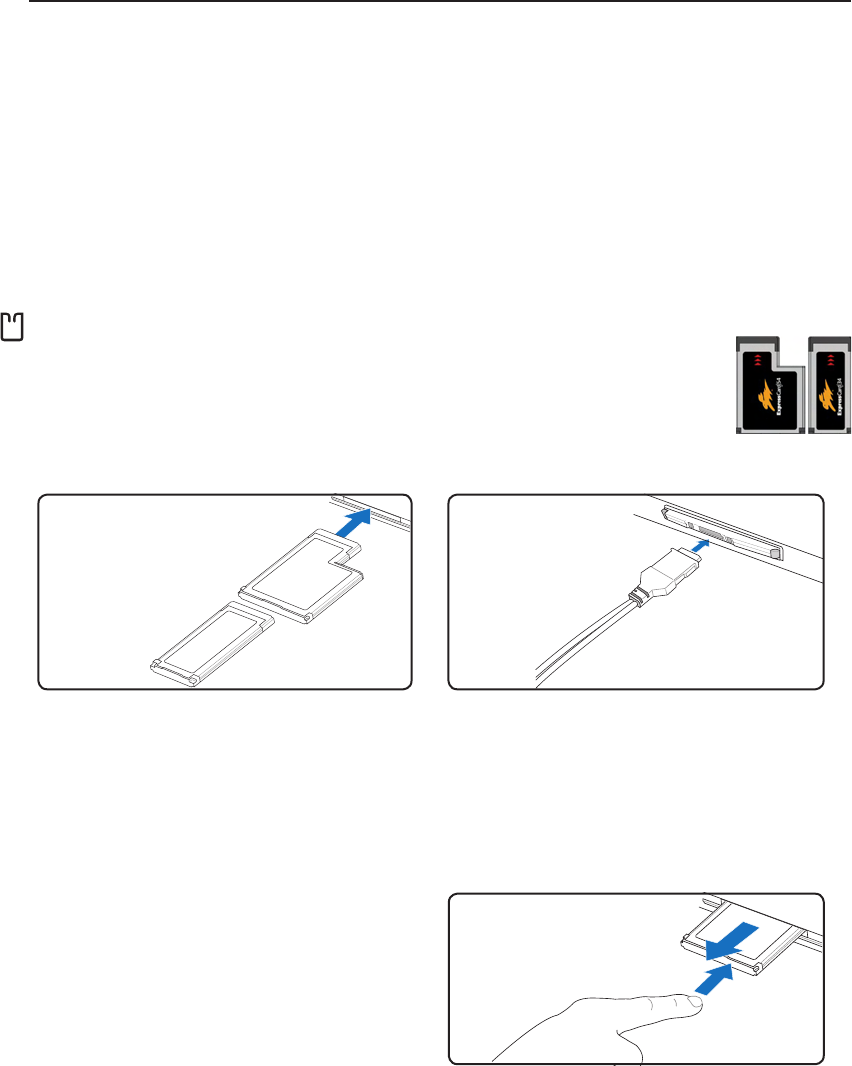
38
4 Using the Notebook PC
Storage Devices
Storage devices allow the Notebook PC to read or write documents, pictures, and other les to various
data storage devices. This Notebook PC has the following storage devices:
• ExpressCard
• Optical drive
• Flash memory reader
• Hard disk drive
ExpressCard
One 26pin Express card slot is available to support one ExpressCard/34mm or one
ExpressCard/54mm expansion card. This new interface is faster by using a serial bus
supporting USB 2.0 and PCI Express instead of the slower parallel bus used in the PC
card slot. (Not compatible with previous PCMCIA cards.)
Inserting an ExpressCard
Be sure the ExpressCard
is level when inserting.
1. If there is an ExpressCard socket protector, re-
move it using the “Removing an ExpressCard”
instructions below.
2. Insert the ExpressCard with the connector side rst
and label side up. Standard ExpressCards will be
ush with the Notebook PC when fully inserted.
3. Carefully connect any cables or adapters
needed by the ExpressCard. Usually connectors
can only be inserted in one orientation. Look
for a sticker, icon, or marking on one side of
the connector representing the top side.
Removing an ExpressCard
The ExpressCard slot does not have an eject but-
ton. Press the ExpressCard inwards and release to
eject the ExpressCard. Carefully pull the ejected
ExpressCard out of the socket.
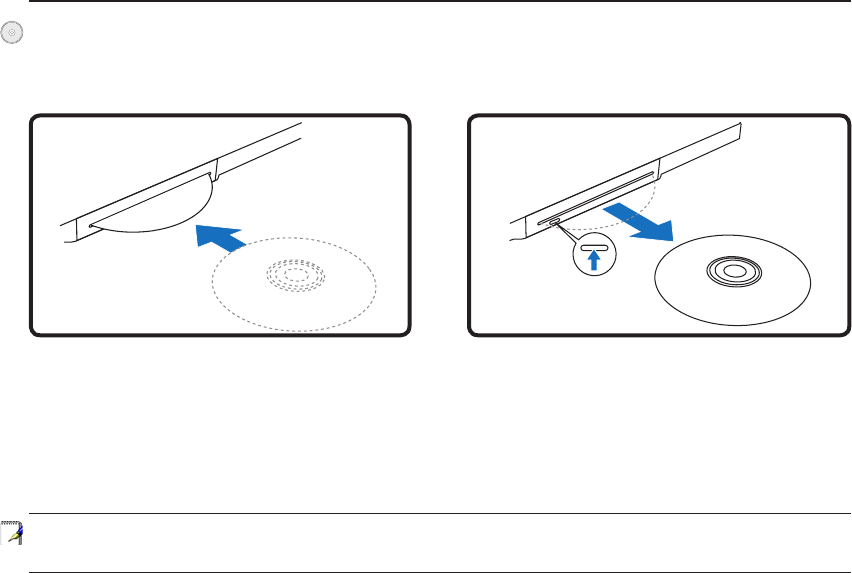
39
Using the Notebook PC 4
Optical Drive
NOTE: It is normal to hear as well as feel the CD spinning with great intensity in the
CD drive while data is read.
2. Gently grab the disc by the edges and pull
straight out.
1. While the Notebook PC’s power is ON, push
the electronic eject button (or use eject from
Windows operating system).
1. While the Notebook PC’s power is ON, insert
a disc slowly and the drive will receive the
disc and bring it in.
Inserting an optical disc Removing an optical disc
A CD drive letter should be present regardless of the presence of a CD disc in the drive. After the CD is
properly inserted, data can be accessed just like with hard disk drives; except that nothing can be written
to or changed on the CD. Using the proper software, a CD-RW drive or DVD+CD-RW drive can allow
CD-RW discs to be used like a hard drive with writing, deleting, and editing capabilities.
Vibration is normal for all high-speed optical drives due to unbalanced CDs or CD print. To decrease
vibration, use the Notebook PC on an even surface and do not place labels on the CD.
Listening to Audio CD
The optical drives can play audio CDs, but only the DVD-ROM drive can play DVD audio. Insert the
audio CD and Windows™ automatically opens an audio player and begins playing. Depending on the
DVD audio disc and installed software, it may require that you open a DVD player to listen to DVD
audio. You can adjust the volume using hotkeys or Windows™ speaker icon on the taskbar.
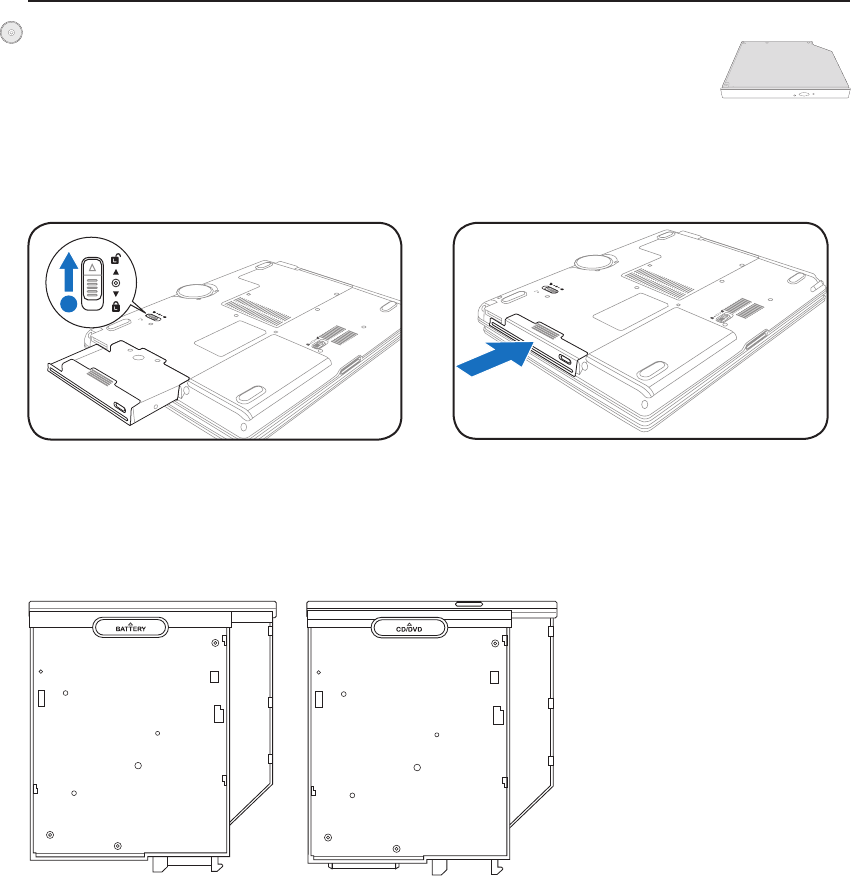
40
4 Using the Notebook PC
1
Inserting a module
Removing a module
Sample modules
Second battery pack Optical drive
Module Bay
This Notebook PC features a module bay to accept various modules such as optical
drives, travel drawer, or second battery pack. Visit an authorized dealer for upgrades.